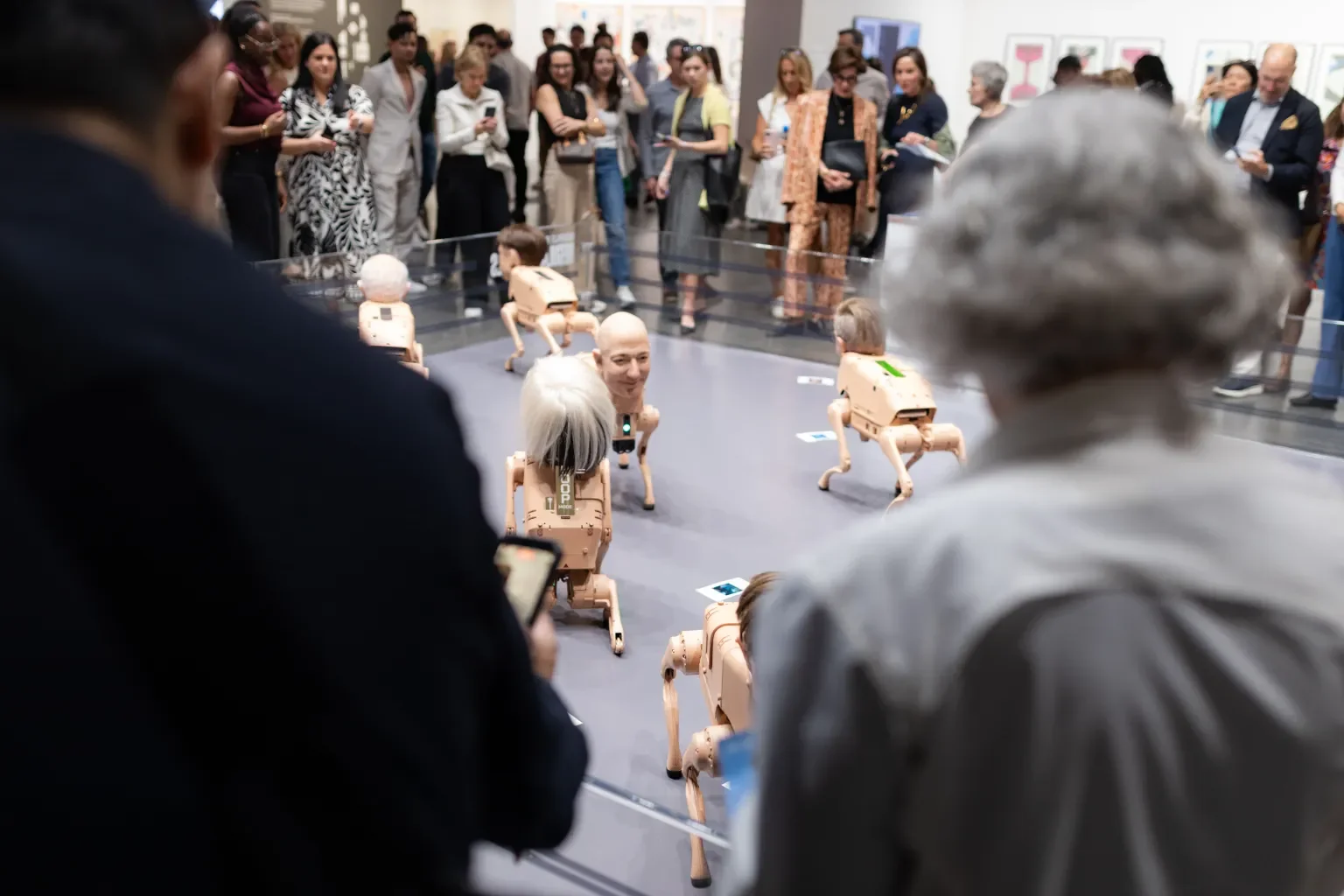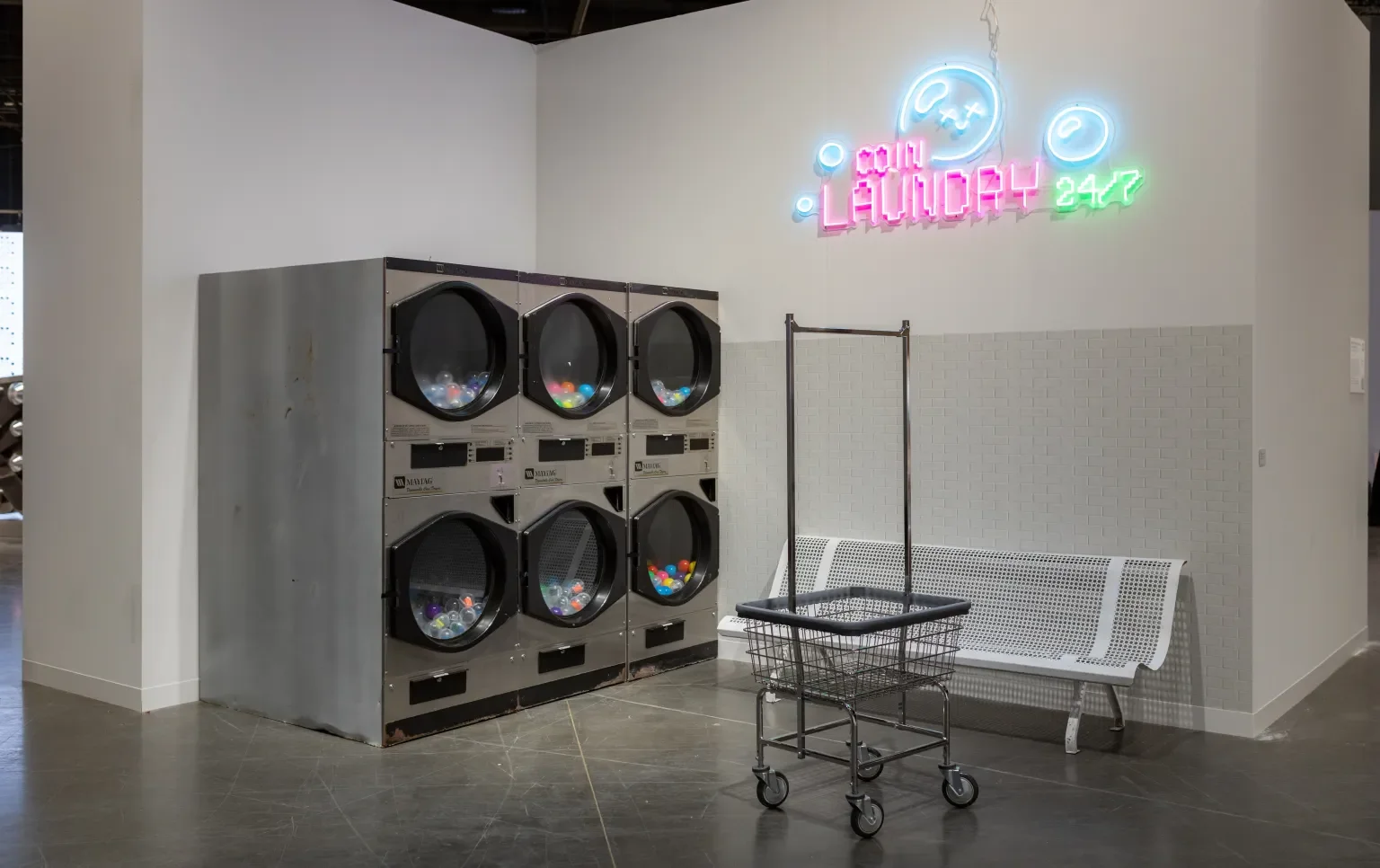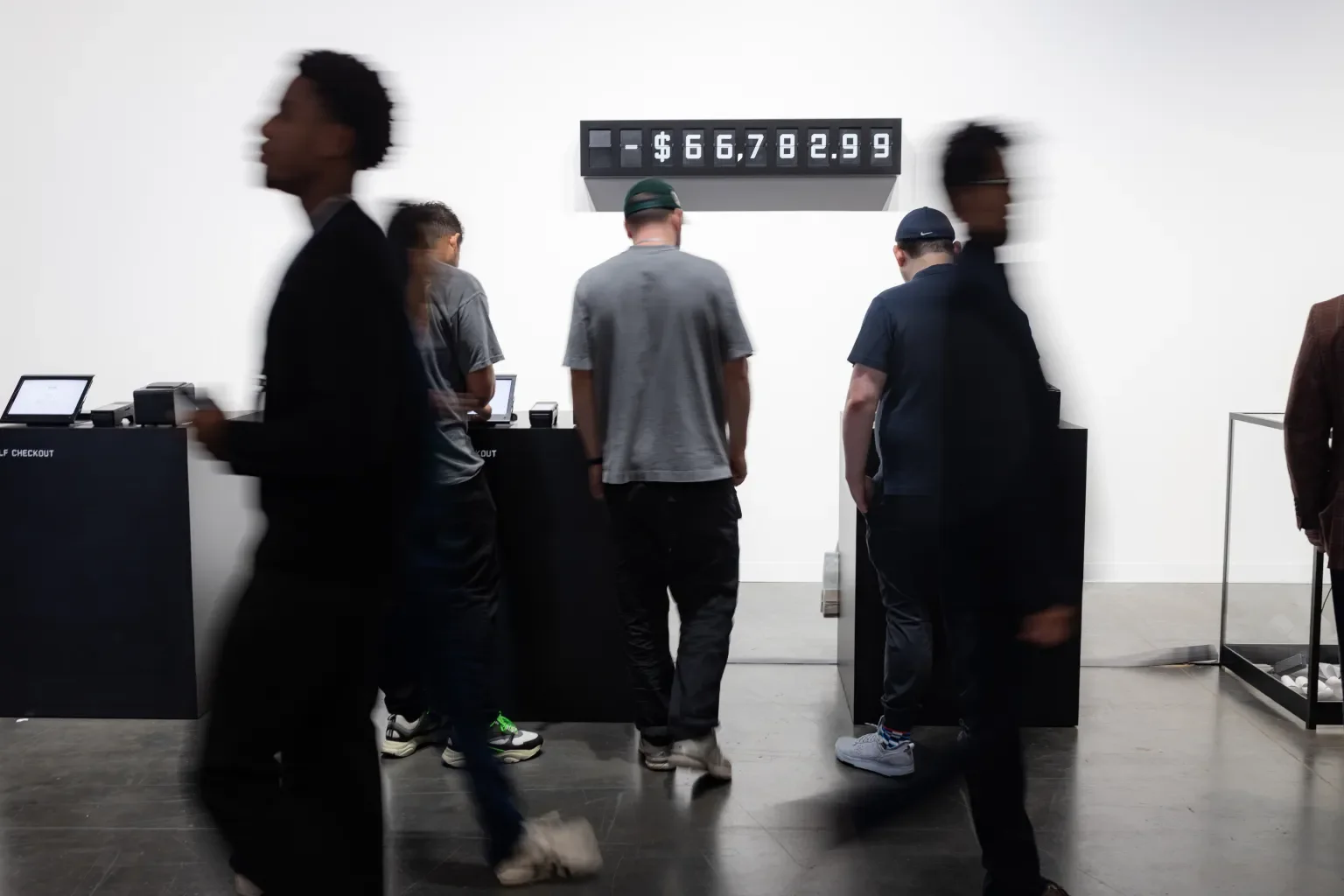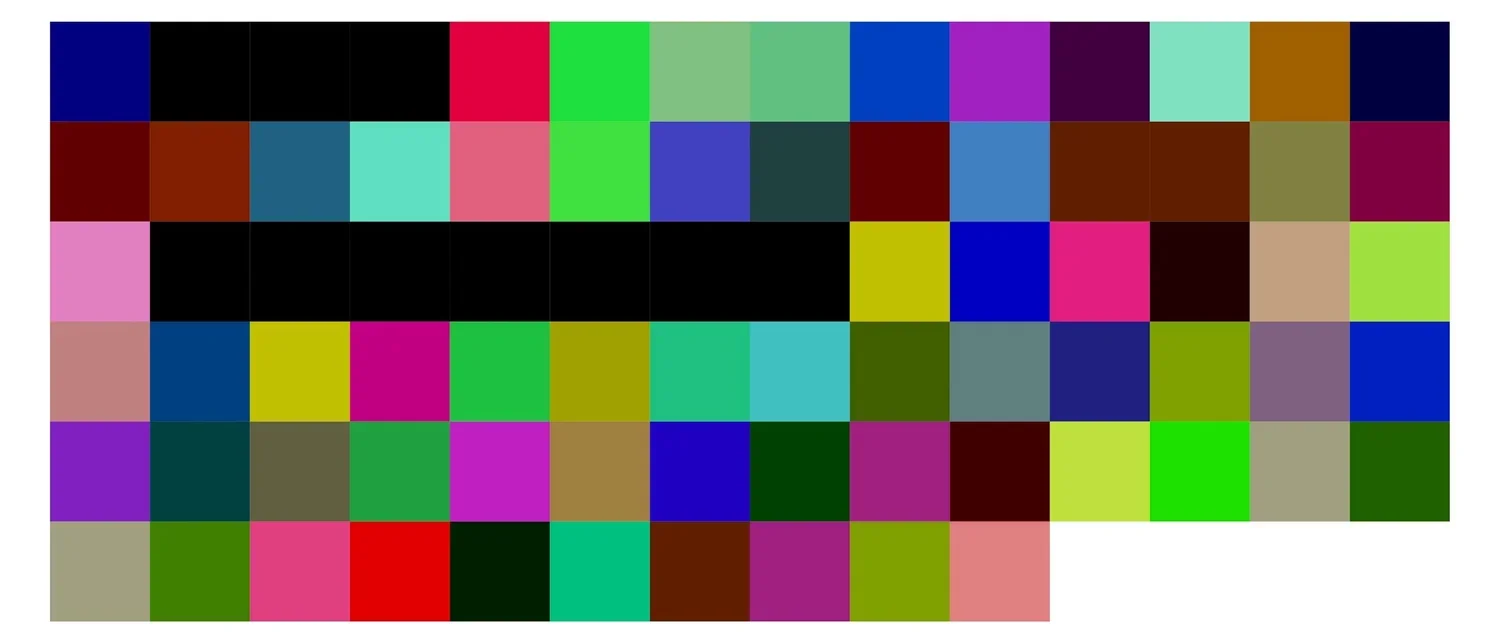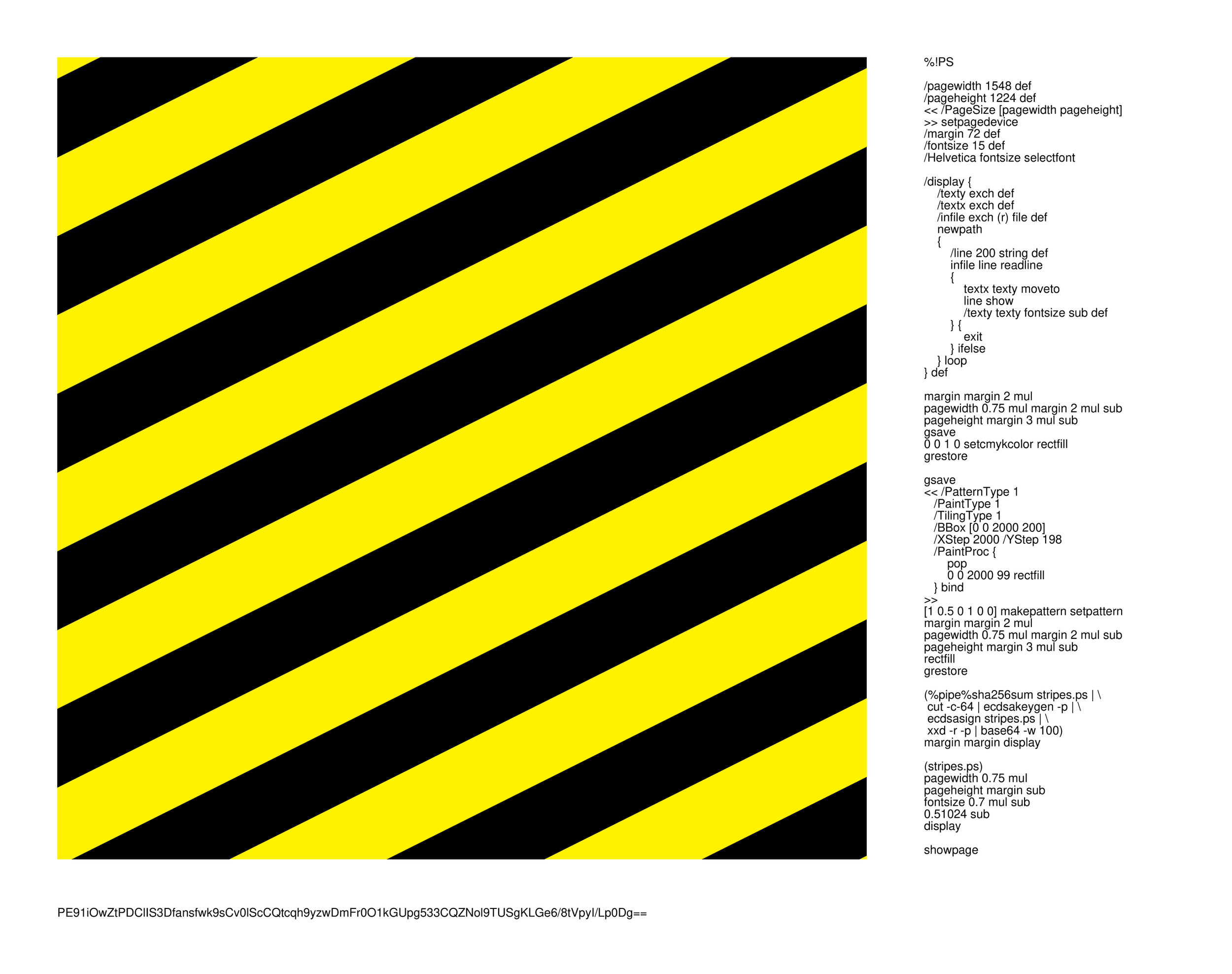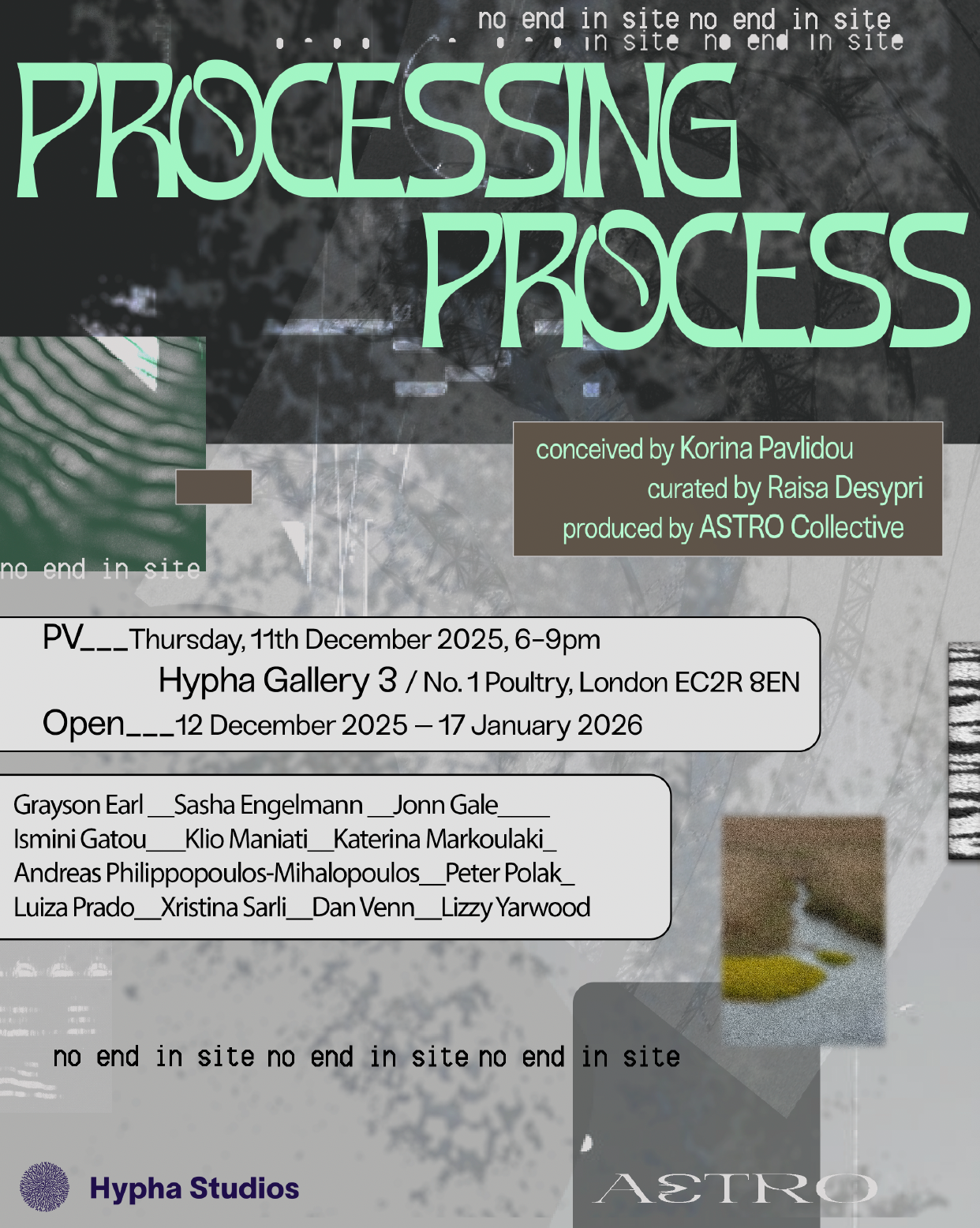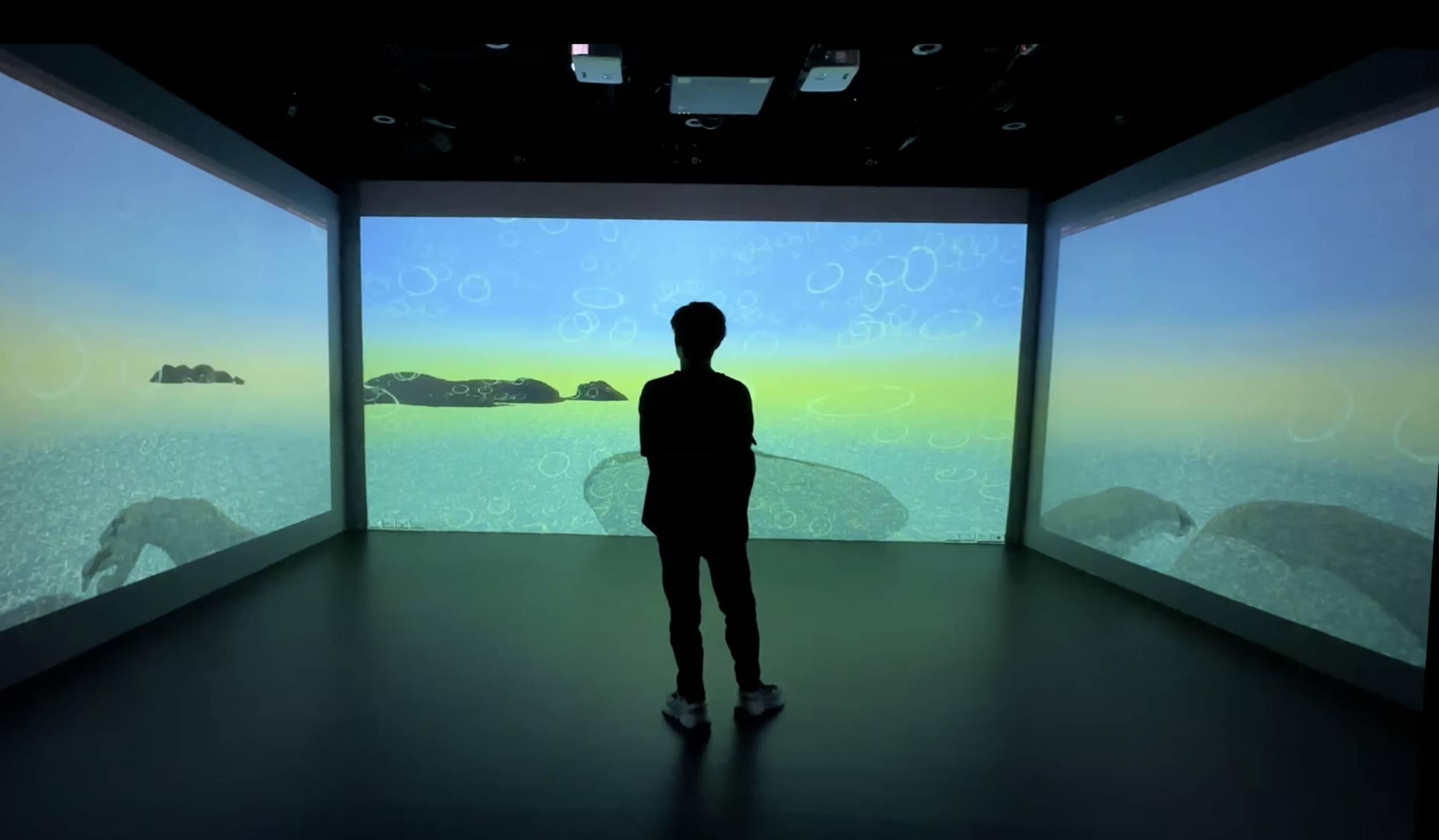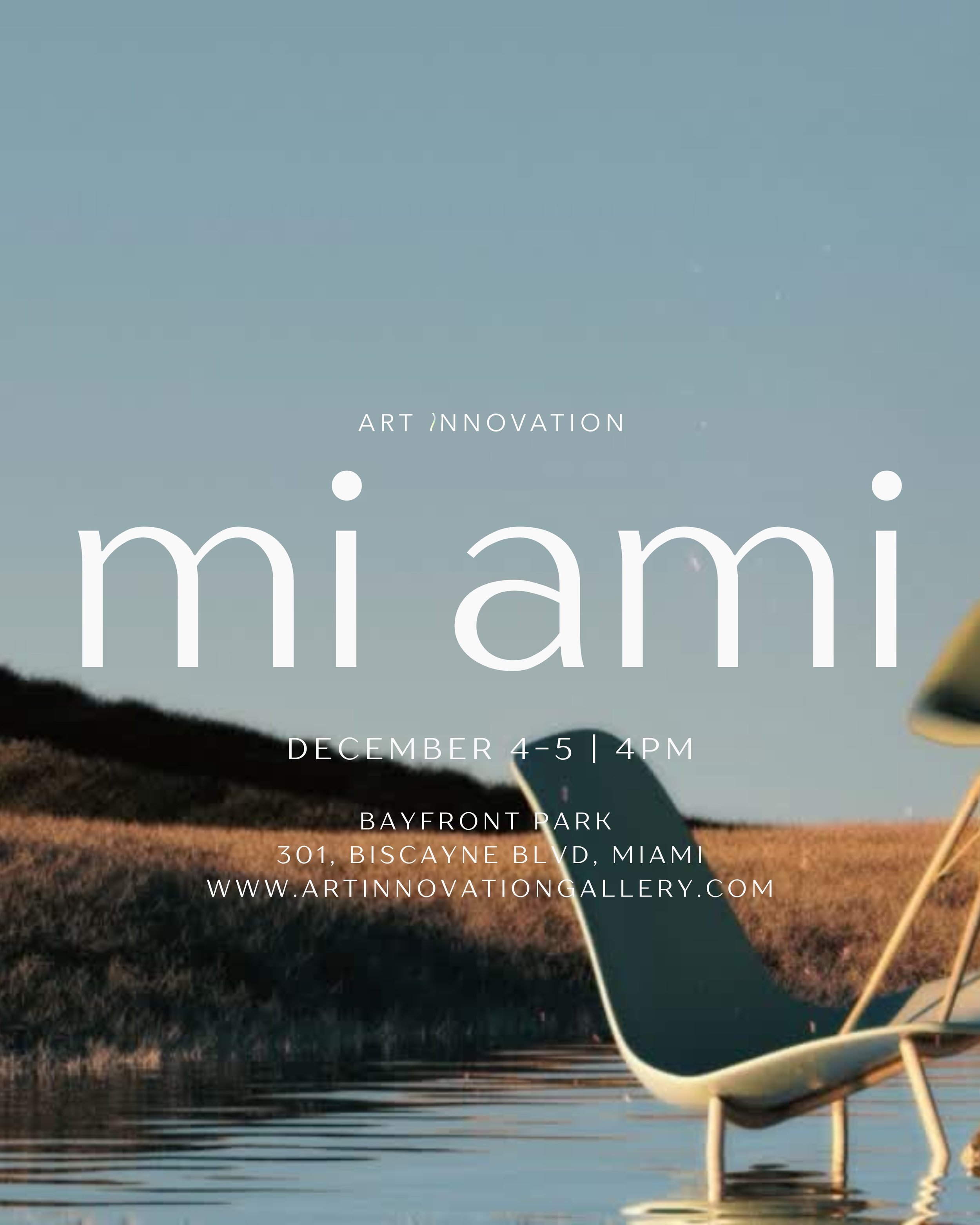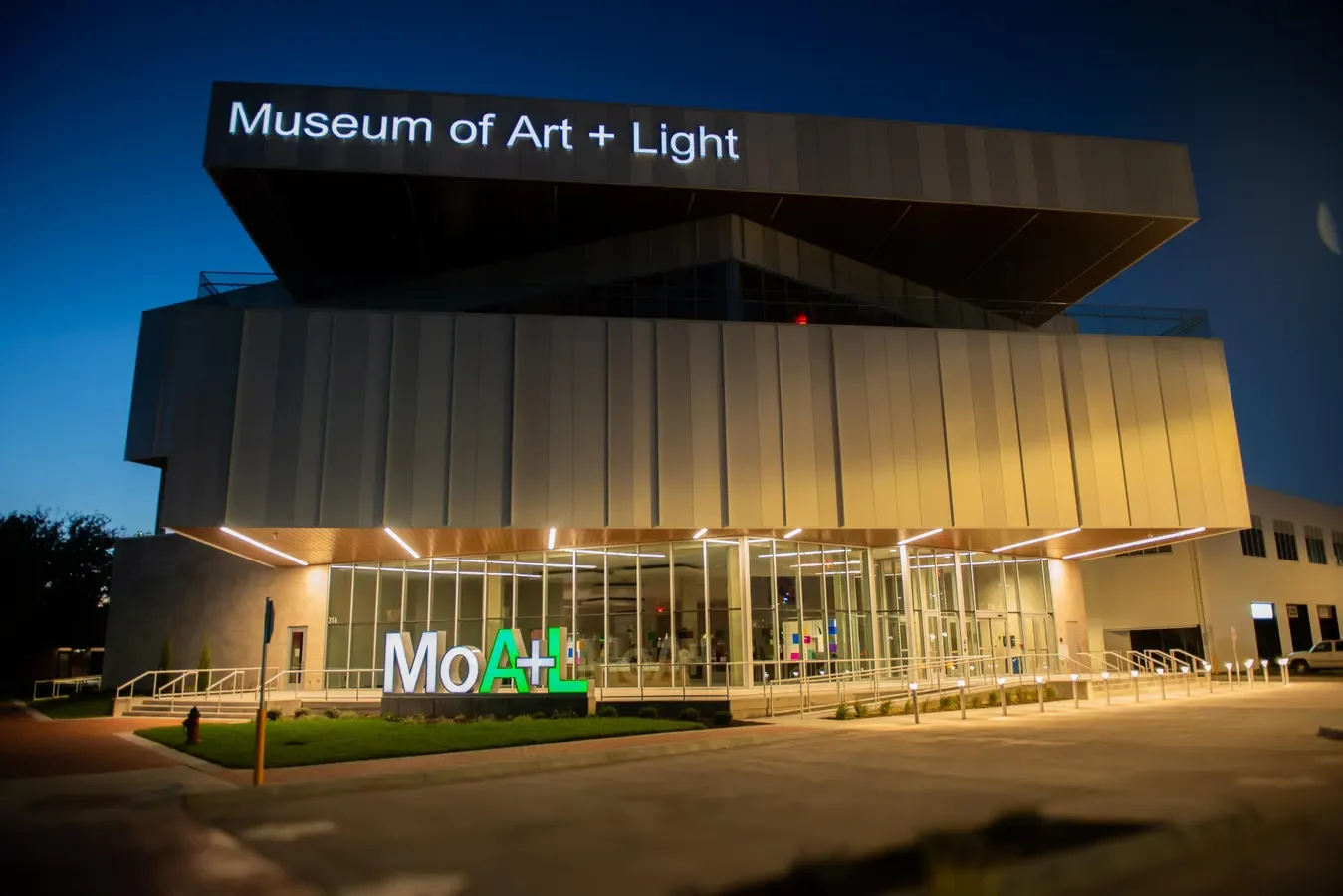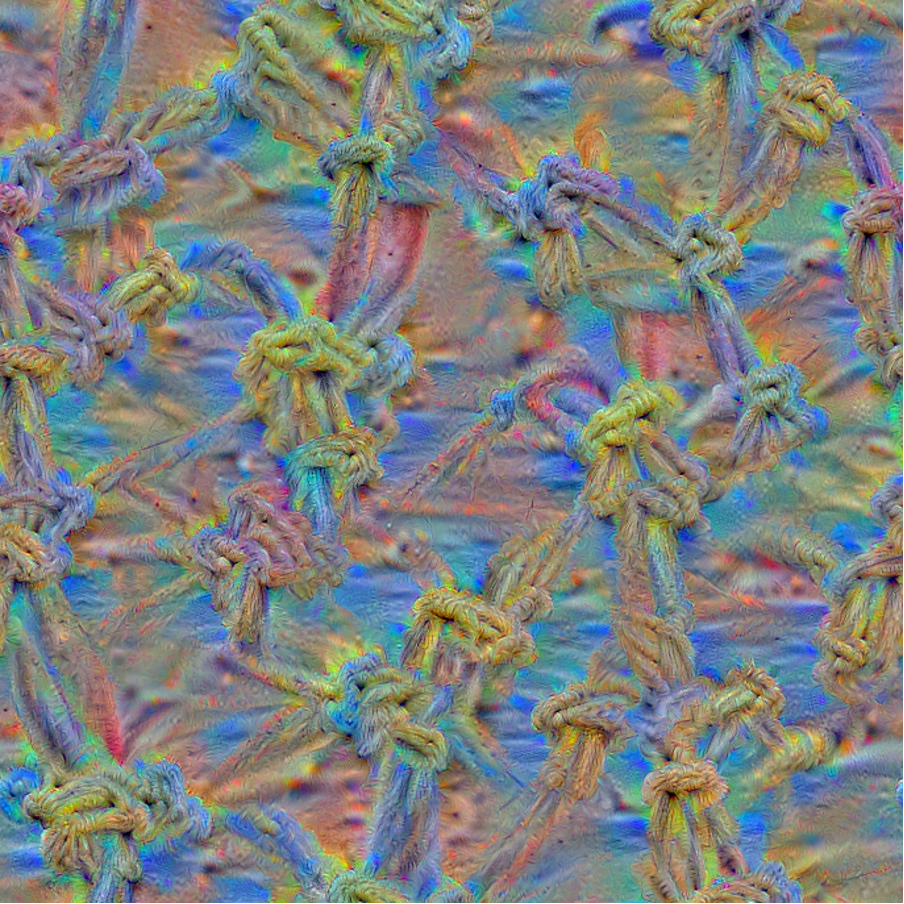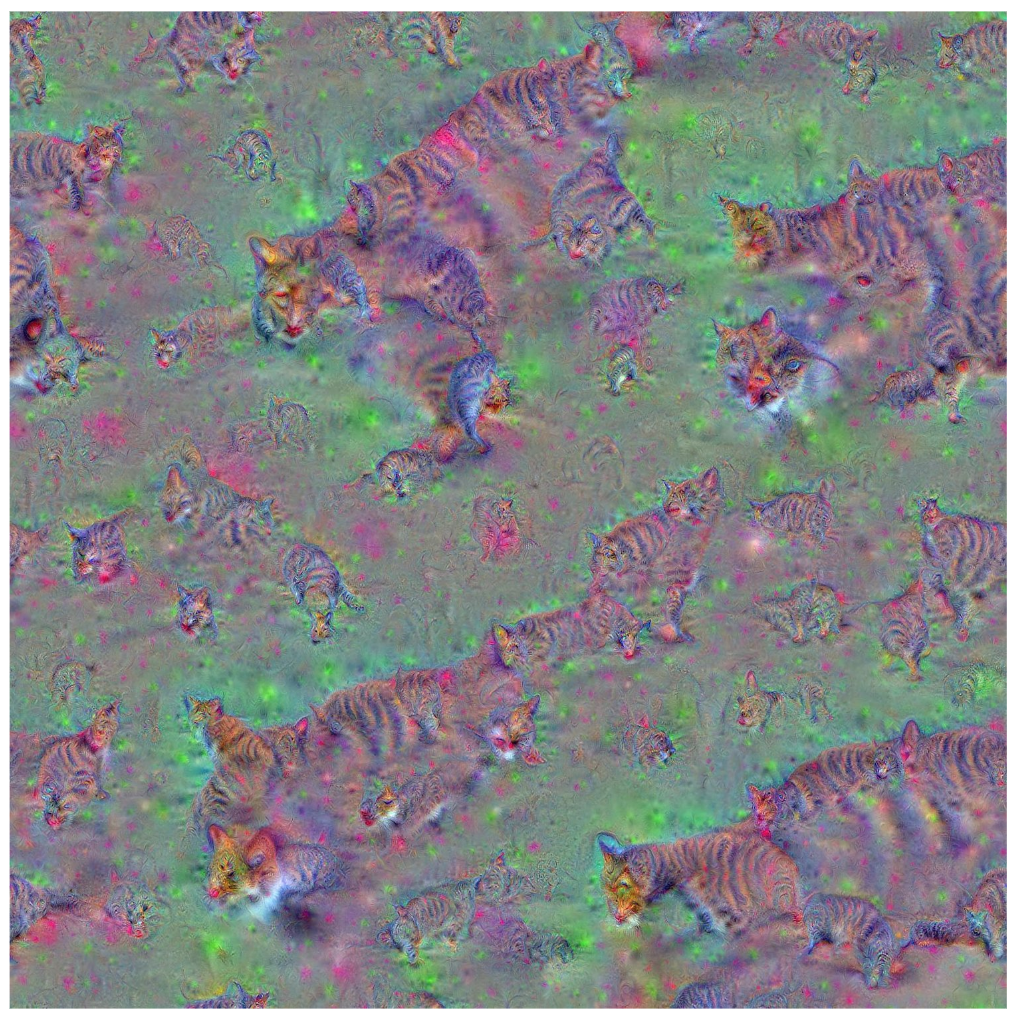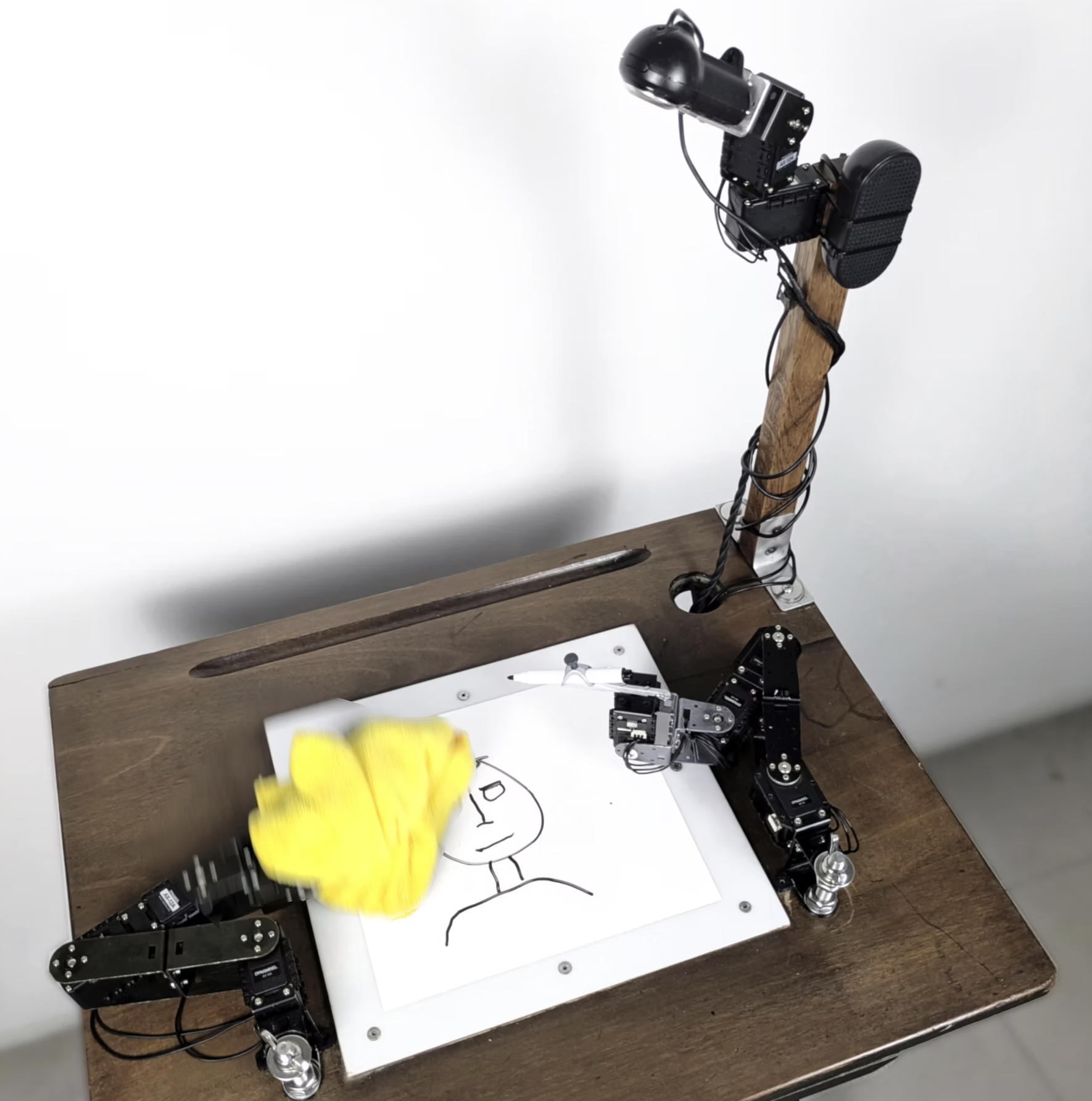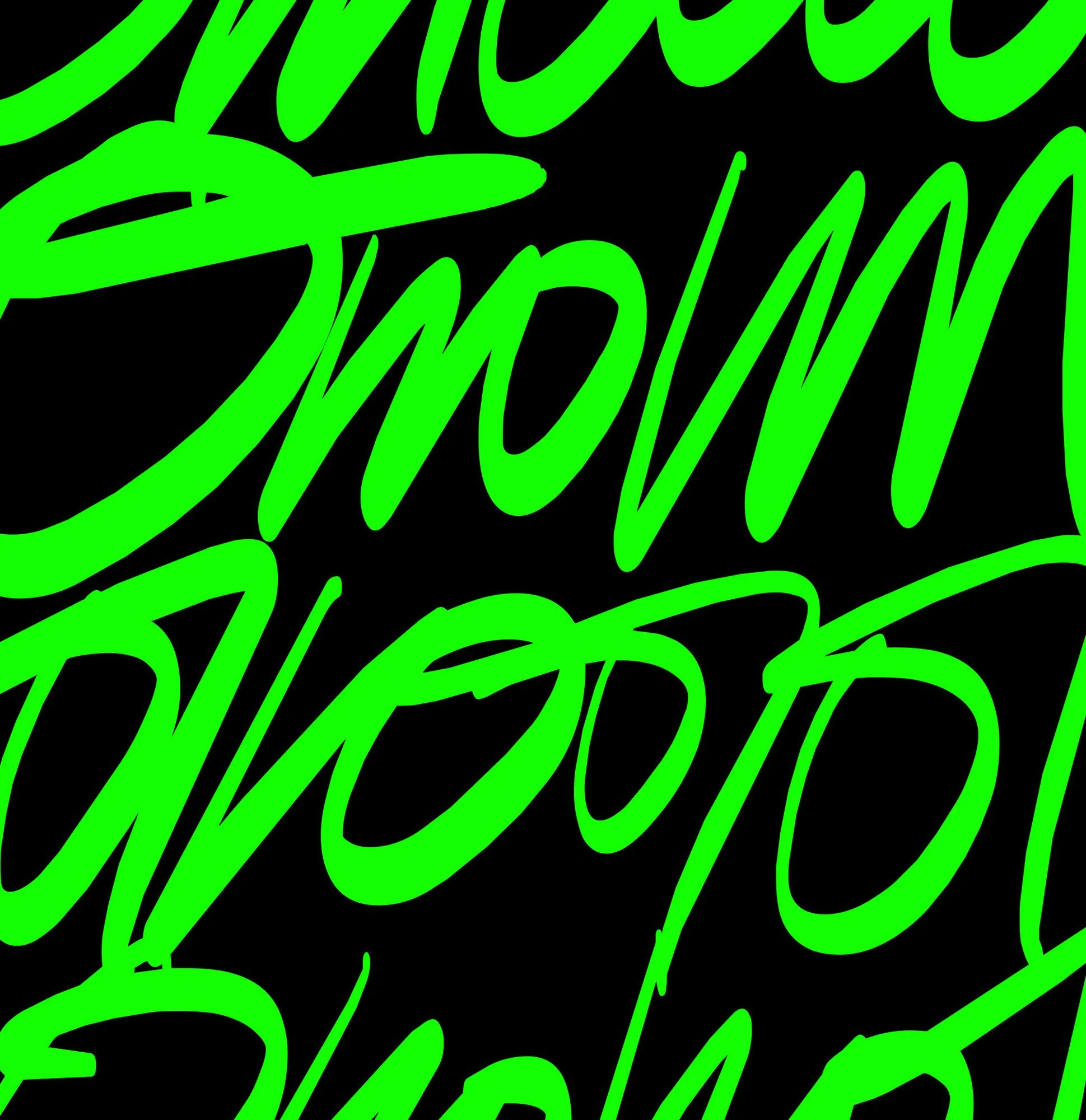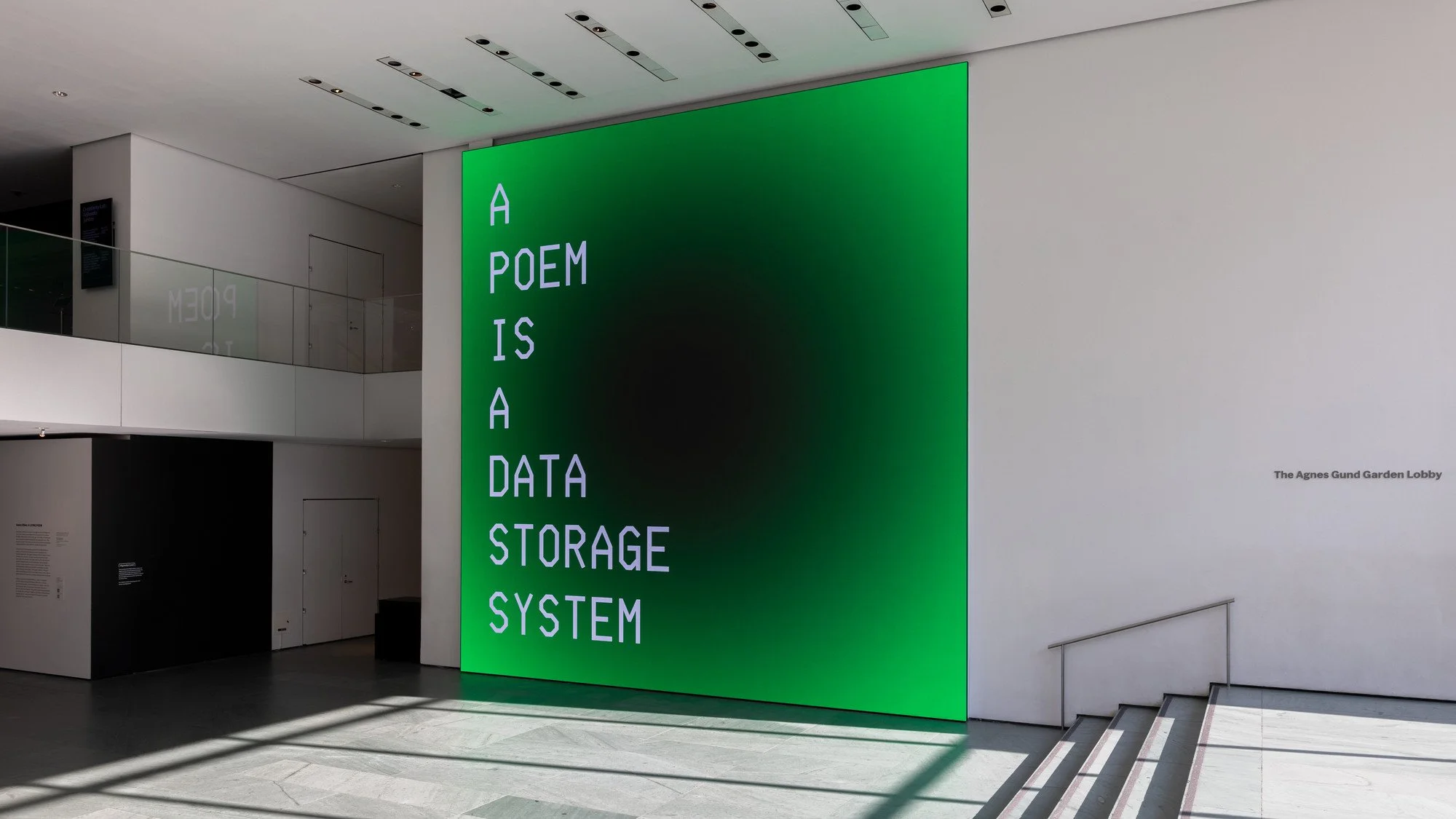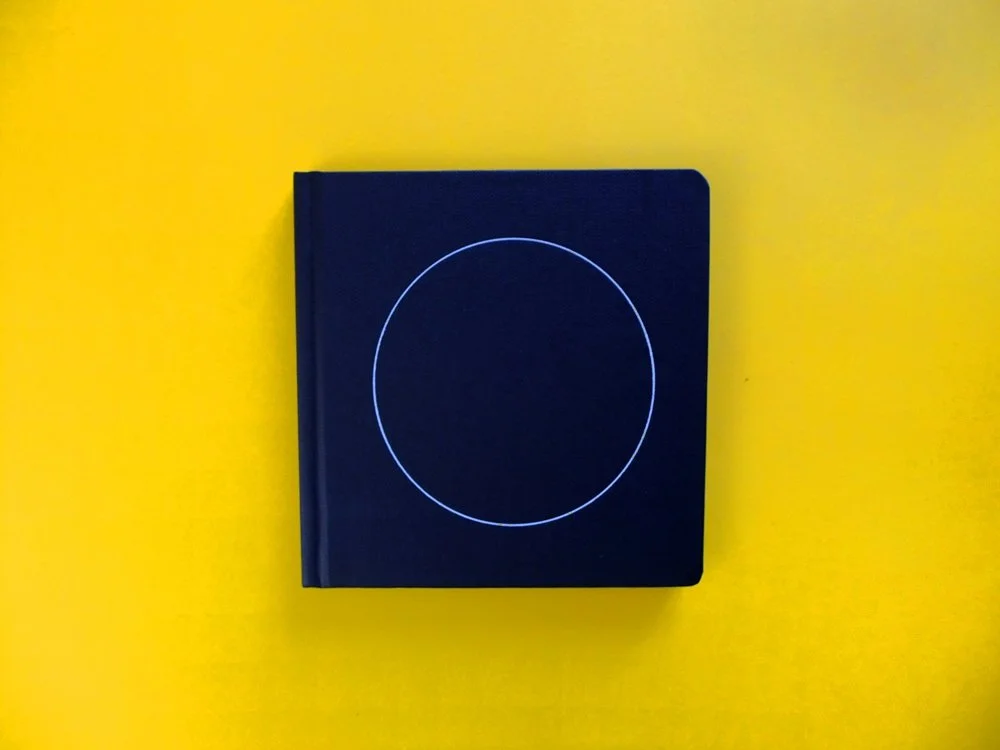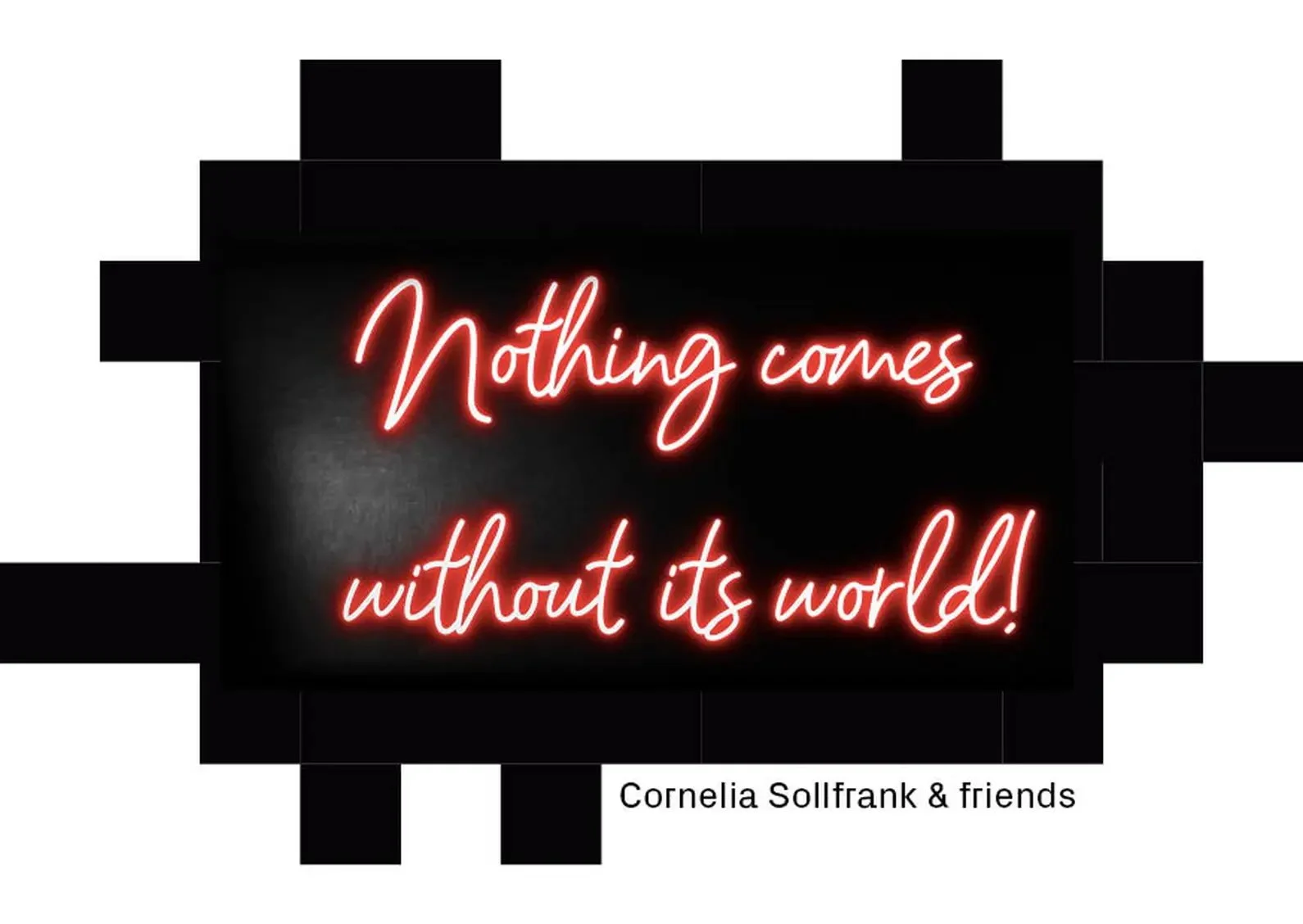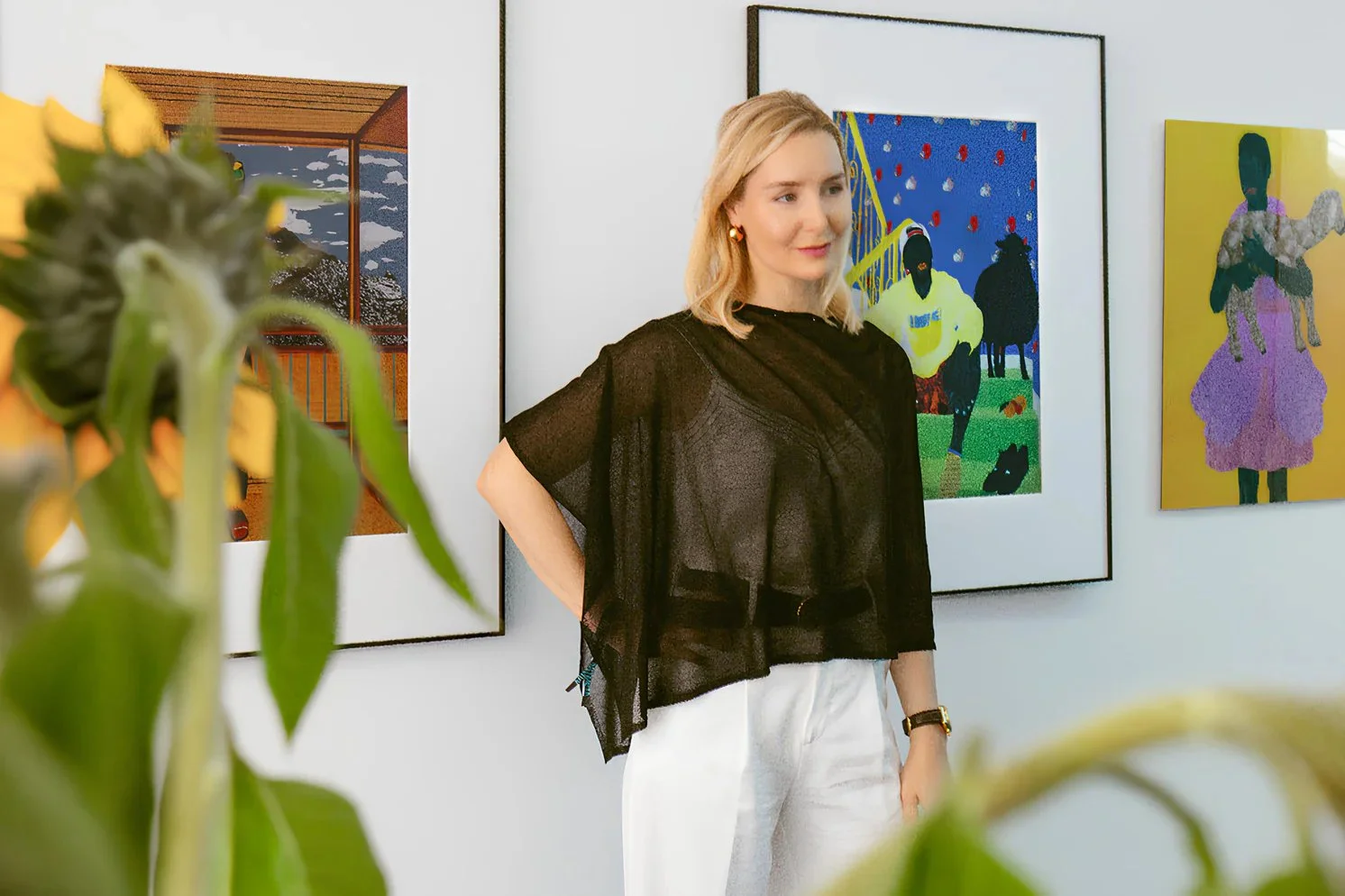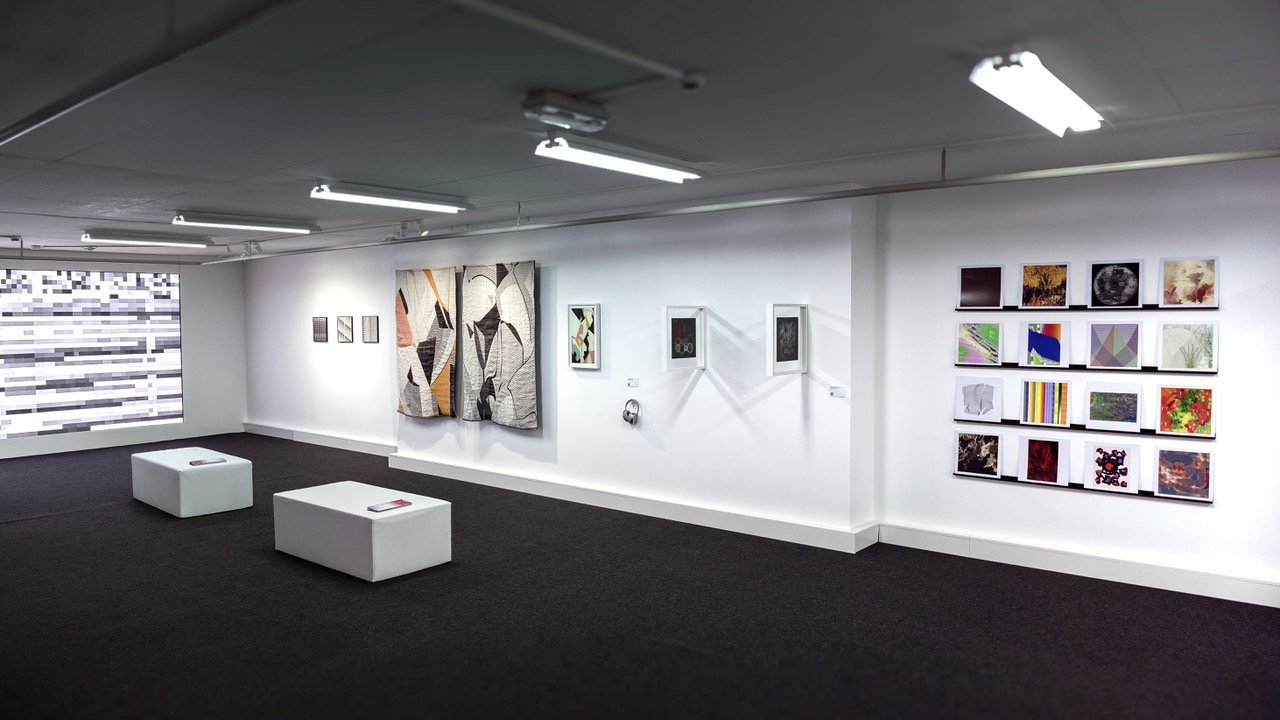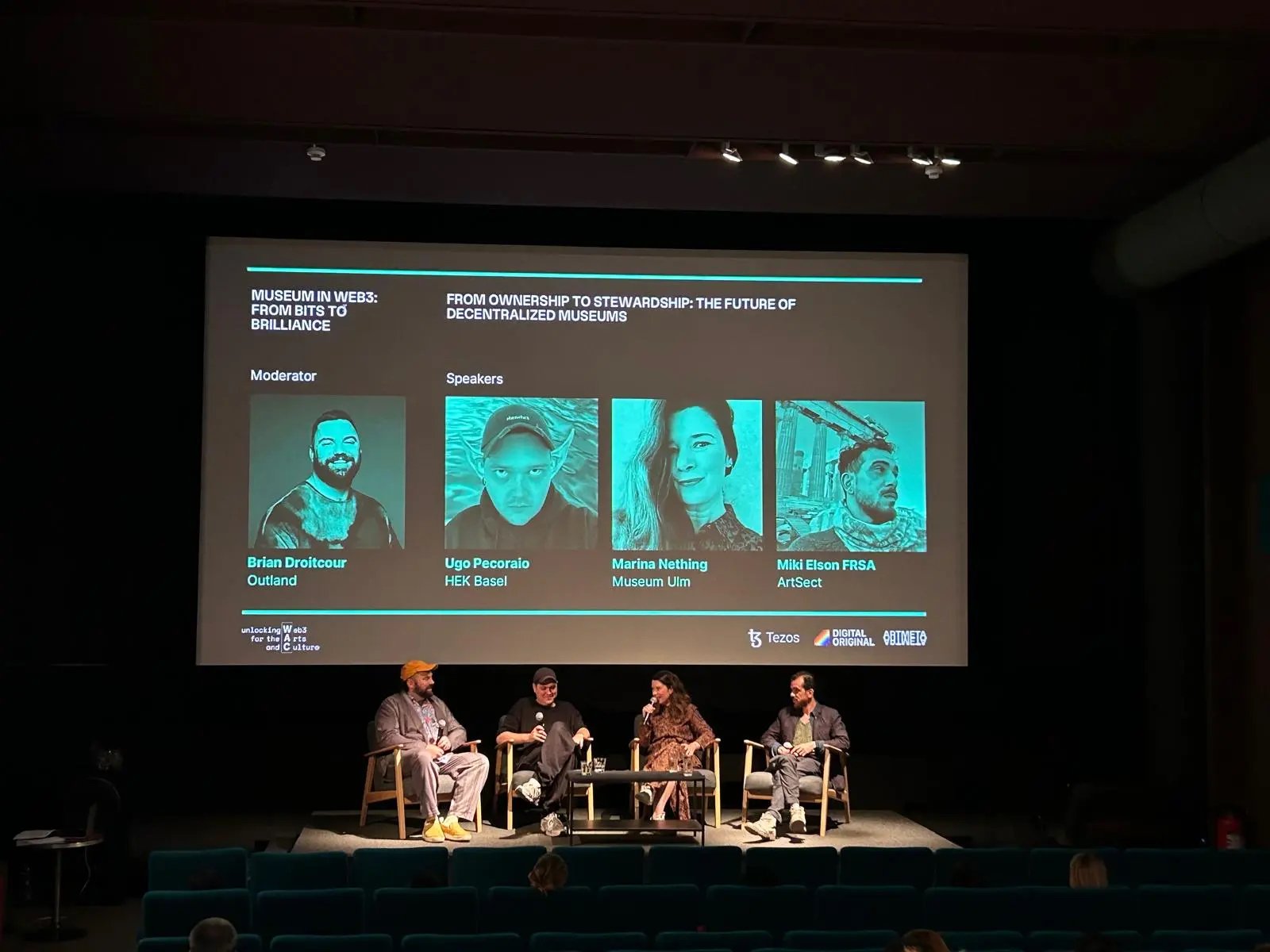Observer References Our Analysis in Its Art Basel Zero 10 Review
Observer’s review of Art Basel Miami Beach 2025 includes a thoughtful reflection on the newly launched Zero 10 digital section. We were pleased to see that the article references ideas from Kate Vass’s essay The Future Has No Walls, published on our blog. Her perspective on how digital art fits into and challenges traditional art-fair structures is included as part of the wider discussion around Zero 10.
Below you can read the full Observer article, “What Zero 10 Can Tell Us About the Art World’s Next Chapter.”
Beeple Studios’ Regular Animals were a viral attraction at Art Basel Miami Beach. Photo: Martina Hoyos. Source: observer.com
What Zero 10 Can Tell Us About the Art World’s Next Chapter
By Elisa Carollo, 12/11/25 2:52pm at observer.com
Art Basel’s debut digital section revealed how Web3 creators, new collectors and shifting infrastructures are reshaping the cultural and economic dynamics around art.
In a year when discussions about A.I. and the role of big tech giants have dominated the news, it feels almost inevitable that the most headline-grabbing artwork at Art Basel Miami Beach—after Catellan’s infamous banana and ATM gimmicks of recent editions—was a work of digital art (or rather, a digital-physical hybrid) by Mike Winkelmann (aka Beeple), the artist who also set the first major record for a purely digital work at a traditional auction with Everydays: The First 5000 Days selling at Christie’s for $69,346,250 in 2021.
Beeple’s record came at the absolute peak of the NFT boom, a moment when speculation, hype and a flood of new collectors drove prices to historic extremes. Yet as crypto values plunged and speculation-driven production saturated the space, the correction was swift and brutal. Enthusiasm curdled into skepticism, then into a cultural fatigue that often registered as outright NFT hate. This did not mean digital art was dead, as evidenced by the crowded VIP opening of Art Basel’s inaugural digital section, Zero 10, where digital connoisseurs mingled with curious traditional fairgoers.
Beeple stole the show with Regular Animals, a performance installation of humanoid robots with hyper-realistic heads of tech titans and art-historical icons—including Mark Zuckerberg, Elon Musk, Andy Warhol, Picasso and Beeple himself—roaming in a ring, capturing photos of visitors, “learning” in real time and excreting art prints and NFTs in their respective styles. Beneath its grotesque humor, the installation doubled as a critique of how technocrats now shape the collective imaginary and of the escalating tension between human creativity and machine intervention. Editions of each “Regular Animal” sold out immediately for $100,000 to longtime collectors, with an additional run of 1,024 prints and 256 NFTs generated from the robots’ snapshots, turning the audience into co-producers.
An installation by XCOPY presented by Nguyen Wahed in Zero 10. Photo: Martina Hoyos. Source: observer.com
In an ArtTactic interview, Beeple noted that Art Basel CEO Noah Horowitz visited his studio multiple times, convincing the fair that it needed to integrate digital art amid clear shifts in collecting habits. “Zero 10 reflects a strategic conviction: digital art is no longer at the margins—it is integral to how art and the market are evolving in real time,” Horowitz said in last month’s launch statement. Beeple welcomed the chance to show at Art Basel Miami Beach, seeing it as an opportunity to “let the outside world peek into this corner of the internet we inhabit,” acknowledging that digital art has long thrived within insider spaces and online echo chambers.
Importantly, Horowitz chose not to treat the section as a satellite or appendage but to integrate it into the fabric of the fair itself, with 10,000 square feet of floor space adjacent to the curated sections at one of the main entrances of the convention center. “I think it is a great continuation of what we’ve been pushing since digital art sort of started to be on more people’s map in 2021,” Beeple told Observer, but he also still thinks there is a lot of work to be done. “One of the things that makes it both exciting and challenging versus other media is that it is changing very rapidly. What is possible, the tools, etc.—these are moving at an insanely rapid pace relative to other mediums.”
Beyond the virality of Beeple’s installation, the twelve galleries and studios presenting in the inaugural edition of Zero 10—curated by digital-art strategist Eli Scheinman—demonstrated the range of evolving trajectories within digital art and how these practices are reshaping the way art is created, experienced and sold.
Underscoring the timeliness of the section was its very title: Zero 10, referencing “0,10,” the groundbreaking 1915 exhibition organized by Kazimir Malevich, the launching moment for Suprematism. That exhibition not only marked a decisive rupture with figuration and a move toward pure abstraction but, as many argue, opened a conceptual line of artistic evolution in which the idea increasingly became more significant than the mastery of execution that had long defined artistic value.
Jack Butcher’s Self Checkout in Zero 10. Photo: Martina Hoyos. Source: observer.com
Perhaps even more telling, Beeple was not the only one selling. The appetite for this work is real, and most exhibitors reported strong early sales that continued throughout the weekend, largely in the four- to six-digit range (in dollars, though this raises another important question we will return to). Many exhibitors told Observer they were genuinely amazed by the response from both traditional and digital buyers alike.
But while the Web3 community showed up in full force—circulating around the booths, buying, posting and supporting this moment of acknowledgment—the section did not arrive without criticism and skepticism, much of it voiced from within the community itself. A provocative article written by Web3 advisor Kate Vass on LinkedIn, for instance, suggested that if the original “0,10” stood for rupture, for burning down systems and starting from zero, this Zero 10 risks functioning instead as a marketing gesture at the world’s most established art fair. “Is this what passes for avant-garde now? A digital corner for ‘innovation,’ sanctioned by tradition and sold to the same collectors it once sought to disrupt?” she asks, pointing out the contradictions inherent to the initiative since Web3 was never meant to live inside walls; it was born in opposition to them. “Trying to fit Web3 art into the architecture of art fairs is like streaming the internet through a picture frame,” she writes, arguing that Art Basel did not lower its entry barriers to embrace a new ideology but to fill economic gaps left by galleries that closed or withdrew earlier this year.
This is certainly one of many points worth reflecting on after the inaugural edition of Zero 10. Here are a few key questions and takeaways.
Advent Collaboration Launches: A 24-Day Series of Digital Artworks
A new digital project, Advent Collaboration, has launched for December, presenting a daily release of one-of-one artworks created in partnership with 25 artists. Conceived and led by artist Jenni Pasanen, the project is structured as a digital advent calendar: each day reveals a new collaborative piece, with processes ranging from animation and digital painting to code-based and experimental approaches.
Across the 24 days, Pasanen teams up with a different guest artist for each artwork. Collectors who complete the full set will also receive an exclusive larger piece by Pasanen. Minting for each daily work is open for 24 hours only, from December 1–24, with the project hosted and displayed through Transient Labs.
Participating artists include:
Jenni Pasanen, A-Mashiro, Chewy Stoll, Raphaël de Courville, Parin Heidari, Ivona Tau, Hannes Hummel, Khwampa, Natalie Shau, Movsum Kior, Manfredi Caracciolo, Mae Somfay, Zhannet Podobed, Esra Eslen, Glitchofmind, Saeko Ehara, Jarvinart, Jesperish, goldcat, Pia Violetta Zironi, David Lisser, OMGiDRAWEDit, and others.
Rhea Myers in Conversation with DIFFRACTIONS
A pioneer of blockchain conceptualism, artist and writer Rhea Myers has spent more than a decade interrogating the cultural, political, and philosophical dimensions of cryptography. In this conversation, published by the DIFFRACTIONS collective, she traces her path from net art to protocol art, offering rare insight into the beliefs, tensions, and contradictions that animate her work.
Rhea Myers. Self-Identifying (2025), PostScript code and NFTs/floppy disks.
The Dark Precursor and its Signature // Rhea Myers
10/31/2025, Published at diffractionscollective.com
Rhea Myers is an artist, hacker, and writer based in British Columbia, Canada, originally from the UK. She makes art to understand the world, mutually interrogating technology and culture to produce new ways of seeing the world as it unfolds around us. Since 2014, she has used the blockchain as a medium for embodying, critiquing, and moving beyond the anxieties of post-financial-crisis society.
Inspired by the histories of conceptualism and net art, Rhea has worked with digital imagery and computer code and produced theory, critique, and fiction as the blockchain art world has gone from the imagination to the mainstream. She didn’t invent NFTs, though. Twice.
Rhea’s art has gained international recognition. It is exhibited globally, sold at prestigious auction houses like Sotheby’s, and collected by renowned institutions such as the Albright Knox Gallery in the US.
DIFFRACTIONS: Can you speak to your personal arc and journey? Your work weaves together a number of threads: philosophical, conceptual art, Free and Open Source Software, cryptographic systems, and the interrogation of self-identity are also bound up with your practice. What were some formative moments, artists or encounters for you?
RHEA MYERS: Ever since I was a child, I’ve wanted to understand the world despite it making no sense to me. It felt like everyone else had a secret rule book or instruction manual for society that someone had forgotten to give me a copy of. So I embraced playing with rule systems that created spaces of relative certainty and simplicity—role-playing games, making art, writing software, using alternative copyright licenses, wrangling cryptography. I can see people raising eyebrows at the idea that any of those are simple, but they are nothing compared to understanding other people.
Because of the artists you mentioned and the popular culture of the time, I went to art school in the 1990s to make that sense by making art with computers. As a result, during the dot.com boom, I lucked into being able to work in tech to support my family while still making art. And did not sleep very much as a result. I focused on obscure technologies so my lack of a computer science degree wouldn’t count against me when applying for jobs (this was totally intentional). I viewed this as a decades-long embedded anthropology study. The experience has informed my art by making sure I’m both intimately familiar with and not naive about the imaginary of technocapital.
The pivotal development for me as an artist was coming to understand cultural reference as representation and composition of it as critique. What Maya B Kronic called “aboutness”. Warhol’s use of mass media and his synthesis of Neo-Dada and Colour Field painting inspired me as I read obsessively through the catalogue of his MoMA show in Sixth Form art class. Jeff Koons’ alignment with capitalism and kitsch to critique race, class, and gender; Art & Language’s indexical materialist art criticism embedded in art itself; and Julian Opie’s similarly project-based work stretched my ability to think about art and its production when I was at art school. Philosophically, by the end of art school, I liked Paul Virilio, Jean Baudrillard, Manuel DeLanda, and Nelson Goodman. If you look closely at my writing, you can see me finally giving in and getting into Deleuze & Guattari via the Ccru around the same time that I got into crypto. It’s important to me that I’m never illustrating my theory or writing apologetics for my art. The work is always the work. I follow the ideas where they take me, into the best medium for realizing them, whether that’s a hand-drawn image, a technical standard, or a data visualization of my brain.
Grayson Earle Joins Group Exhibition at Hypha Studios in London
Grayson Earle will take part in the upcoming exhibition Processing Process ~ No EnD In Site, opening at Hypha Studios Gallery 3 in London. Curated by Korina Pavlidou in collaboration with Raisa Desypri and produced by ASTRO, the exhibition brings together twelve international artists whose work explores relationality, transformation, and process-based artistic practices across disciplines. The show runs from 12 December 2025 to 17 January 2026, with a preview on 11 December.
Processing Process ~ No EnD In Site
Concept • Research • Text by Korina Pavlidou
Processing Process ~ No EnD In Site brings together a transdisciplinary group of artists exploring relationality, transformation, and the dynamics of process at the intersection of social research, the life sciences, and biotechnology. Conceived and developed from the research of Korina Pavlidou and articulated through her framing of Process-Oriented Ontology, the show is curated in collaboration with Raisa Desypri and produced by ASTRO.
The exhibition features twelve international artists (in alphabetical order): Grayson Earle (@prismspecs); Sasha Engelmann (@sasha_intheair); Jonn Gale (@balkanjonn); Ismini Gatou (@ismini_gatou); Klio Maniati (@kokomania); Katerina Markoulaki (@cath_ki); Andreas Philippopoulos-Mihalopoulos (@picpoet); Peter Polak (@sicknessinternational); Luiza Prado (@luizap); Xristina Sarli (@xristinasarli); Dan Venn (@dan.venn) and Lizzy Yarwood (@zil_doorway).
Processing Process ~ No EnD In Site becomes a living ecology of processes, highlighting the relationality, uncertainty, and unquantifiable nature of process-led artistic practices. The show probes embodied, emplaced, and ensensed materiality in constant flux, activating Gallery 3 as a metastable environment where artworks are not presented as fixed objects but as processes that generate further processes. The exhibition challenges a thing-oriented ontology, which frames existence as isolated, countable, monetised, and individual entities, and instead moves toward a relational understanding of the world. Drawing on fungal-inspired meshes and transpoiēsis the show questions closed, antirelational, autopoietic systems, while trans-dividuality and transdividuation challenge the individual as an ontological condition and individualism as a mode of governance. These themes guide the exhibition’s exploration of care and destruction, artificial intelligence and heritage, queering death, and the oscillation between discipline and indiscipline.
Processing Process ~ No EnD In Site gathers an ensemble of works that traverse mixed media drawing, painting, sculpture, photography, moving image, site-specific sound work, archival and participatory research, and bioart. Across media and method, the exhibition unfolds as a study in transformation, in conversation with the process-oriented research of Korina Pavlidou. From pigment to pixel, from microbe to signal. From the intimacy of ink and paper to the algorithmic, the ecological, the sonic and the olfactory. Artworks engage calligraphic traditions, digital systems, and material transformations in oil and light, film and sound, data and code, mycelium and ash. Each work articulates distinct yet interconnected traces and threads of lived experiences, and modes of making and unmaking, learning and unlearning. Together, these diverse artworks explore how matter and systems decompose and recompose, decay and regenerate, and exist by happening through unbound, continuous, and inconclusive process. Through this expanded field of practice, the exhibition becomes a space where listening, writing, sensing, smelling, and coding coexist, and where the boundaries between art, research, and environment remain porous, fluid, and open to change.
Processing Process ~ No EnD In Site presents a Public Programme running from Thursday December 11 December 2025 to Saturday 17 January 2026. Coming together through relation, the show facilitates public philosophy practices, handson workshops, and philosophy-for-children-and-youth workshops, focused on process over product, improvisation over instruction, and relationship over resolution. Through participatory, research-led, and spatially activated practices, the show invites audiences to engage with creation as an ongoing, relational, and transformative encounter. The opening on 11 December 2025 (7:30–8:00 pm) features Hydra: The Contract, performed by Andreas Philippopoulos- Mihalopoulos. On Saturday 13 December 2025 (4:00–6:00 pm), curator Raisa Desypri will walk through the exhibition in conversation with Korina Pavlidou during the Curatorial T(w)alk. On Wednesday 17 December 2025 (6.00–8.00 pm), Korina Pavlidou will present Living Unstill | Between Object-Oriented and Process-Oriented Ontology in the Arts, sharing the research and conceptual groundwork behind the exhibition. Following the winter recess, the programme resumes on Saturday 10 January 2026 with Process as an Exploration (for Youth), led by Vasilia Sofroniou and Dana Wait (11.00 am–1.00 pm), and Foxfire Fungiverse, led by Xristina Sarli (4.00–6.00 pm). The programme concludes on Friday 16 January 2026 (7:00–9:00 pm) with Matt Bluemink’s, Foam Cities: Peter Sloterdijk’s Atmospheric Philosophy, presented in collaboration with BlueLabyrinth magazine. All workshops and talks will take place in the gallery space at Hypha Studios Gallery 3 No. 1 Poultry, London EC2R 8EN.
TIME/LOCATION
PV: Thursday, 11 December 2025, 6-9pm
Performance Hydra: The Contract by Andreas Philippopoulos-Mihalopoulos at 7:30pm
Open: 12 December 2025 – 17 January 2026
Opening times: Wed - Fri: 2 - 6pm / Sat: 12 - 6pm or by appointment
Winter recess: 21 December 2025 – 6 January 2026
Hypha Studios Gallery 3 / No. 1 Poultry, London EC2R 8EN
Tamiko Thiel Debuts New Works in Munich and New York
We are delighted to share two upcoming exhibitions by Tamiko Thiel, presented this winter in Munich and New York. Known for her pioneering work at the intersection of art, technology, and immersive environments, Thiel debuts ParadoQc/Machines, a newly commissioned AR livestream installation exploring the quantum structures of the strontium atom, at the ERES Stiftung in Munich. Shortly thereafter, she travels to New York for the Tribeca launch of ONX Studio’s new space, where Atmos Sphaerae will be shown for the first time as a three-screen immersive installation.
ParadoQc/Machines AR livestream immersive installation. Installation view at the ERES Foundation, 2025.
ParadoQc/Machines at “Seeing the Unseen”, ERES Stiftung, Munich
ParadoQc/Machines is an AR livestream installation that offers a detailed view into the quantum levels of the atom and the ways in which the quantum properties of superposition and entanglement are now used to build computers from these quantum states. While many types of quantum computers exist, this work focuses on the neutral atom quantum computer, as it allows these quantum properties to be shown clearly through the structures of the atoms and their electron probability clouds.
The work is commissioned by the ERES Foundation for the exhibition "Seeing the Unseen: Quantum physics and art as entangled worlds," which will open on 04 December 2025 and run until 26 September 2026.
Seeing the Unseen explores the mysterious, enigmatic, and counterintuitive. Anyone who ventures into the world of quantum physics often has to take a leap of faith. Particles that are also waves, probabilities instead of certainties, realities that only manifest themselves through observation: the world at the smallest scale defies our imagination, forms the basis for radically new technologies such as quantum computers, and also fascinates artists.
With the exhibition “Seeing the Unseen”, the ERES Foundation invites visitors on an interdisciplinary journey into the quantum world. One hundred years after the pioneering achievements of Niels Bohr, Werner Heisenberg and others, the latest scientific findings meet contemporary art. In the show, the themes of quantum physics intertwine in Elsa Garmire’s psychedelic laser shows, overlap in Tamiko Thiel’s mixed reality installation, and unfold in the expanding and shrinking spaces of Mehmet & Kazim or in Tan Mu’s painterly homage to the chandelier-like beauty of golden quantum computers.
With the excellence cluster Munich Center of Quantum Science and Technology (MCQST) the ERES Foundation has gained a cooperation partner that provides scientific support for the project. An outstanding lecture programme offers insights into one of the world’s leading epicentres of modern quantum physics – Munich.
Welcome to the parallel world of crazy tiny units. Perhaps you will be floating on “Cloud Q” as well after visiting “Seeing the Unseen”?
Artists: Dara Birnbaum, Herbert W. Franke, Elsa Garmire, Ayoung Kim, Alicja Kwade, Roman Lipski, Jonas Lund, Mehmet & Kazim, Tan Mu, Semiconductor, Thomas Struth, Paul Talman, Tamiko Thiel, Troika, Agustina Woodgate, and others
TEST of Atmos Sphaerae as immersive projection space. Recorded at ONX Studio New York/Onassis Foundation.
Atmos Sphaerae at "Under the Radar" Festival, New York
Atmos Sphaerae combines mythic imagery with the poetic beauty of the „Lewis structures“ scientific notation to make visible the atomic composition of molecules in the atmosphere. It takes the viewer from the pre Big Bang VOID to the mythic cosmic egg, to the disc of proto-planetary gases out of which the Earth formed, to the life-giving water, to the mythic islands of Mother Earth, then to the photosynthesizing cyanobacteria that trigger the Great Oxygenation Event that created the conditions for life as we know it to arise on Earth, and finally ends in a runaway greenhouse triggered by humans‘ voracious appetite for fossil fuels.
Atmos Sphaerae was originally created for the DiMoDA 4.0: Dis/Location VR exhibition, curated by Christiane Paul. It premiered in 2021 at Gazelli Art House, London, as part of their gazell.io digital art program, and shown by them at ART Singapore 2025. Other exhibitions include at the ZKM Karlsruhe, SIGGRAPH Art Gallery 2025 (curated by Francesca Franco) and the 2023 Istanbul Digital Art Festival (IDAF), curated by Julie Walsh.
The work will be presented by Onassis ONX in the exhibition “TECHNE Homecoming at Onassis ONX” as an immersive three-screen installation in the new ONX space at 390 Broadway in Manhattan, as part of the Under the Radar Festival (UTR).
Laura Rautjoki at “Mi Ami” During Miami Art Week
We’re excited to share that Laura Rautjoki will be among the artists showcased in the “Mi Ami” exhibition during Miami Art Week. Presented on a floating LED platform navigating between Miami Beach and Downtown Miami, the project highlights the latest in AI art, new media art, and immersive digital design practices.
20/11/25, Milan IT by www.artinnovationgallery.com
Digital Art and Design Exhibition on a Floating LED Platform
An exhibition curated by Art Innovation Gallery
Art Innovation Gallery presents “Mi Ami”, a digital art and design exhibition taking place during Miami Art Week alongside Art Basel. The project stands out for its experimental and alternative character, offering a curatorial journey set on a large-scale floating LED platform navigating from Miami Beach to Downtown Miami.
The title “Mi Ami”, a wordplay that simultaneously evokes the city and poses an intimate question to the viewer (“Do you love me?”), introduces a reflection on the relationship between place, image, and audience. The exhibition fosters an open dialogue between digital practices and the urban–aquatic environment that hosts them, transforming the experience into an encounter between technology, identity, and perception.
The artworks will be showcased on December 4 and 5 starting at 4:00 PM, through an immersive program featuring creations by selected artists and designers from around the world.
The LED boat will make a scheduled stop for public viewing from 4:00 PM to 4:45 PM on both days at Bayfront Park – 301 Biscayne Blvd, Miami.
The exhibition unfolds across three main curatorial sections, each exploring distinct approaches and visual languages:
FOCUS – A thematic investigation that delves into a specific subject, technique, or digital language, offering a concentrated and critical perspective.
SOLO – Monographic presentations dedicated to individual artists or designers, providing a more intimate and structured understanding of their practice.
BRAND – A section exploring the intersections between digital design, creative brands, and contemporary visual culture, examining how experimental aesthetics meet commercial innovation.
Through these sections, “Mi-Ami” presents a dynamic itinerary that highlights the plurality of digital languages and the diversity of global artistic practices.
The floating LED platform—an essential component of the project—is not merely an exhibition space but an urban narrative device, capable of transporting art through two symbolic areas of the city and inviting the public into an unexpected and engaging visual encounter.
The artists: Eva Benal, Creativa Magazine, ARTHOUSE.NYC, Samuvel Benhursha, SpaceKkabbi, Amanati, Siniša Koprivnjak, Medina Kasimova & .ART Registry, Ryan Neil from Bonsai Mirai and Josh Jen.
Art Innovation is a company that combines art, technology, and marketing to create artistic events on a global scale. Using advanced LED screen technology, it transforms art exhibitions into immersive experiences, allowing the public to enjoy art in an interactive way.
The company offers brands the opportunity to integrate their content into artistic experiences, increasing visibility and creating contacts with an international audience.
Art Innovation stands out for its ability to combine creativity and technology, creating events that enhance art and offer practical and effective marketing solutions.
DATE / LOCATION
4-5 Dec. 2025
Bayfront Park – 301 Biscayne Blvd, Miami
From 4PM
Museum of Art + Light Acquires Sasha Stiles’s THE WIND ON MY LIPS AND IN MY HAIR
THE WIND ON MY LIPS AND IN MY HAIR, 2024 by Sasha Stiles
28.10.2025.
The Museum of Art + Light (MoA+L) announces the acquisition of THE WIND ON MY LIPS AND IN MY HAIR (2024), an LED neon poem sculpture by poet–artist and AI researcher Sasha Stiles, for the museum’s permanent collection. The work has been generously donated by Kate Vass and the artist.
THE WIND ON MY LIPS AND IN MY HAIR extends Stiles’s acclaimed AI-crafted poetics into neon sculptural form. Building on the lineage of text-based light works and acknowledging neon’s nostalgic heritage, the sculpture brings Stiles’s AI poetry out from behind the screen and into physical space. Rendered in the artist’s signature fluid cursive font, the work evokes both the cybernetic and the organic. The illuminated verse fuses message and material in an immersive interplay of light, code, and meaning.
The work builds on Sasha Stiles’s transmedia practice, which reframes poetry as both art and technology through long-standing exploration of human–machine collaboration. Sasha Stiles is a first-generation Kalmyk-American poet, artist, and AI researcher, who, since 2018, has pioneered human–machine collaboration—most notably with Technelegy (2021), co-authored with a personalized AI model. Her award-winning projects such as Cursive Binary and Repetae explore authorship, memory, and the future of creative intelligence. Recognized by institutions and prizes including Prix Ars Electronica, the Sigg Art Prize, and the Lumen Prize, Stiles has exhibited and performed internationally from Lincoln Center, MoMA, and the V&A to Kunsthalle Zürich, Outernet London, and Shibuya Crossing.
The donation is made possible through a partnership with Kate Vass (Zürich), an independent art initiative whose program spans established, mid-career, and emerging artists deeply engaged with new technologies. With a sustained commitment to media art and its cutting-edge developments, Kate Vass offers a discerning perspective on digital, generative, AI, and new media practices. She represents Sasha Stiles and has presented her work at leading international platforms, including Untitled Art Fair in Miami (2024), where the donated sculpture was first featured in the program.
MoA+L was founded in 2021 to bring 21st-century technology into dialogue with the visual and performing arts. Adding Stiles’s neon poem continues the museum’s support for artists working with new tools and formats, and builds on its commitment to thoughtful presentation and conservation of technology-based art for broad publics. MoA+L has been long purpose-built to unite immersive, digital, and physical experiences under one roof, offering a natural context for Stiles’s work.
LOCATION:
The Museum of Art + Light
316 Pierre Street
Manhattan KS 66502
USA
The Museum of Art + Light, Manhattan KS, Source: artlightmuseum.org
Alexander Mordvintsev wins the Swiss AI Award 2025
Alexander Mordvintsev, the creator of DeepDream, has received the Swiss AI Award at the Culture & Society “AI Awards Night”, held at Kraftwerk Zürich as part of Swiss {AI} Weeks 2025.
Alexander Mordvintsev, Just before DeepDream: fractalization #3, 2015/04
Swiss {AI} Weeks is a nationwide initiative uniting researchers, developers, entrepreneurs, and citizens to shape ethical, responsible, and collaborative AI. With over 150 partners, 240 events, and 33 participating cities, the movement showcases how innovation “Made in Switzerland” can generate real societal and cultural impact. Running from September 1 to October 5, 2025, the program features hackathons, expert talks, public workshops, and community meetups across Basel, Bern, Geneva, Lausanne, Zurich, and beyond — transforming Switzerland into a living laboratory for the future of AI.
As part of Swiss {AI} Weeks, the AI Awards Night took place on September 28, hosted by Singularity Is Here in collaboration with Swiss {AI} Weeks and powered by QSTAR Research. The event celebrates outstanding achievements at the intersection of technology, ethics, and culture — with the support of Impact Hub Zürich, Kraftwerk Zürich, and other partners.
Left: Alexander Mordvintsev presenting at the AI Awards Night / Right: Alexander Mordvintsev with Kate Vass during the AI Awards Night
This year marked the 10th anniversary of DeepDream, the groundbreaking algorithm that transformed how we see and think about artificial intelligence. In recognition of this milestone, its creator, Alexander Mordvintsev, received a well-deserved award during the event. The award honors not only his pioneering contribution to AI research but also the lasting cultural and artistic impact of DeepDream, which continues to inspire both scientists and artists a decade later. To mark the occasion, Alexander presented “Deep Dream Decade: Celebrating 10 Years of Neural Hallucinations” — reflecting on how a late-night experiment in 2015 evolved into a global cultural phenomenon and how DeepDream’s legacy continues to shape the dialogue between art and technology today.
Alexander Mordvintsev is a Zurich-based researcher and artist best known for inventing the DeepDream algorithm — a milestone in AI image generation that revealed how neural networks “see” the world. Developed during his time at Google, DeepDream inverted the image-recognition process, allowing networks to amplify and visualize their own internal patterns. The resulting complex, hallucinatory images became an instant global sensation. Beyond its visual impact, DeepDream reshaped how both artists and scientists approach AI creativity.
Alexander’s visionary contribution is now celebrated with the Swiss AI Award 2025 — a well-deserved recognition of his enduring influence on both technology and culture.
Alexander Mordvintsev, Cats, 2015/05
Machine Arts Group at AI+X Summit 2025
E-David, the painting robot by Michael Stroh
Last week, we had the privilege of attending the AI+X Summit 2025 at StageOne in Zurich, which became the epicenter of Switzerland's AI ecosystem. The summit brought together over 2,000 participants, 150+ speakers, and 65+ exhibitors and partners. Organized by ETH AI Center, UZH.ai, and ZHAW Zurich University of Applied Sciences, it has established itself as a cornerstone event since its inception in 2021.
The summit featured an ambitious program spanning multiple domains, including healthcare, finance, legal applications, education, science, and biodiversity. The main and innovator stages hosted keynotes and panels on entrepreneurship, Responsible AI, and Generative AI, with speakers representing world-leading institutions such as ETH Zurich, Meta, MIT, EPFL, Google Switzerland, the University of Helsinki, and TUM München. Meta also participated in the event, presenting Inside Meta, an immersive experience featuring demos with Meta Ray-Bans and Quest devices.
Imaginative drawing machine by Patrick Tresset
The exhibition zone showcased several innovative installations. Artists including Gonçalo Guiomar, Johannes Stelzer, Alexander Loktyushin, and Carlo Angelini presented Submersion, an interactive experience where visitors' images and spoken prompts were reinterpreted in real time by advanced diffusion models, creating surreal visual transformations. Another installation,Training Grounds, curated by AATB, featured a humanoid robot in simulated sleep, with subtle movements paired with screen displays of fragmented visions.
However, the highlight of the event was the Expressive Machines exhibition, curated and presented by the Machine Arts Group—an evolving art-tech space located in Zurich and dedicated to AI-assisted physical art-making by artists and researchers working at the intersection of computer science, robotics, and contemporary art. The group fosters new forms of collaboration between artists and intelligent machines, focusing on the creative potential of embodied AI. Participants included Patrick Tresset (Belgium), known for his autonomous drawing agents; Sofie Mart (Switzerland), who explores new techniques in image processing; and Michael Stroh, who developed the painting robot e-David at the University of Konstanz (Germany).
Multimedia art-making system by Sofie Mart
The exhibition brought together three installations by these artists. Each featured a live robotic system powered by custom AI protocols, offering a rare glimpse into the emerging aesthetics of non-human authorship. Tresset presented autonomous drawing agents, Michael Stroh showcased a painting robot he developed, and Sofie Mart performed with image-interpretation techniques—using artifacts from ETH Zurich’s image archive as subjects and allowing her robotic machine to learn and develop a machine-native visual language in its drawing.
Expressive Machines bridges this gap through robotic systems that not only generate images but perform them—translating perception into gesture and code into brushstroke. It poses the question: is a machine merely an extension of human intent, or could it—by developing a sense of aesthetics, materiality, and spatial awareness—become creative on its own?
A LIVING POEM by Sasha Stiles at MoMA, NY
We are happy to share Sasha Stiles: A LIVING POEM exhibition, opened on September 10, 2025, in the Agnes Gund Garden Lobby at MoMA. This show invites visitors to experience an ever-evolving text, where human imagination and artificial intelligence merge to create new poetic forms. Through her collaboration with Technelegy, an AI alter ego trained on her own voice and writing, Stiles transforms the museum’s Garden Lobby into a living notebook—one that rewrites itself every hour, reminding us that language, like life, is always in motion.
What does it mean to be human in the age of artificial intelligence? Since 2018, artist and poet Sasha Stiles has explored this question through collaborations with her alter ego, Technelegy, an evolving AI system trained to emulate and augment her writing and voice. Their projects consider how human and machine minds process language, shaping new forms of expression for a rapidly changing world.
The next step in their ongoing experiment is A LIVING POEM, an infinite text powered by human imagination and computer algorithms. Inspired by text-based art from the Museum’s collection, the poem rewrites and performs itself anew every 60 minutes. Each page comes to life in real time via a bespoke language model, intricate prompting, custom datasets, and sensory elements such as voice, sound, and visuals. The words appear in multiple fonts, including Cursive Binary. This custom typeface—fusing the artist’s handwriting with the zeros and ones of binary code—offers a poetic metaphor for humanity’s evolving relationship with technology.
Stiles has described this work as a “poem in residence,” transforming the screen in the Museum lobby into an autonomous notebook. A LIVING POEM includes an intimate, immersive soundscape by Stiles’s studio partner, Kris Bones, that reminds us of poetry’s roots in oral tradition. This auditory experience is accessible via QR code. Together, these layers form a dynamic language system—a poem that reveals itself moment by moment, always becoming, never finished.
Location: MoMA, Floor 1, Garden LobbyThe Agnes Gund Garden Lobby
Date: Sep 10, 2025–Spring 2026
Julien Gachadoat Releases Noir Orion
We’re excited to share the release of Noir Orion, a new artist’s book by Julien Gachadoat. Limited to 200 signed and numbered copies, the 64-page volume is printed on 140g Sirio Black paper and bound in a sewn hardcover format.
RRose Editions, 2025
Edition of 200 signed & numbered copies. 64 pages. 15 x 15 cm. Printed on 140g Sirio Black paper. Sewn bound hardcover
“Noir Orion” is a sketchbook of 63 drawings generated by an algorithm designed to explore the gradual transformation of a simple shape: the circle. On each page, the algorithm applies a series of geometric operations that evolve the circle into increasingly elaborate configurations. Then, in a reversing motion, the forms simplify until they return to lines evocative of a star. The book’s visual trajectory weaves a connection between pure mathematical abstraction and a cosmic entity.
Cornelia Sollfrank & friends “Nothing comes without its world!” (HAP Grieshaber Prize of VG Bild-Kunst 2025)
On the occasion of the presentation of the HAP Grieshaber Prize 2025, Cornelia Sollfrank takes the invitation to a solo exhibition as an opportunity not only to present a selection of her own works, but also to provide insight into the “world” that this work has helped to create: a long-standing relational network of Berlin-based and international agents.
Since the early days of the World Wide Web in the 1990s, Cornelia Sollfrank has been exploring how the potential of digitally networked media can be used to question traditional aesthetic categories and experiment with new forms of political engagement. In her artistic and academic work on digital cultures, she repeatedly deals with artistic infrastructures, new forms of (political) self-organization, critical authorship, the aesthetics of the commons, the performativity of data, and techno-feminist practice and theory.
One of her main areas of work is the paradoxes that copyright law creates in the digital age. Her multi-part work This is not by me explores questions of authorship and originality. It includes videos, collages, performances, and texts, all revolving around the iconic Warhol flowers. She calls her method “performative copyright infringement,” which also forms the basis of her practicebased PhD (2011). During her ten years of engagement with copyright law, she developed a particular interest in commons, especially digital commons, on which she has also done research and published. Based on gender-specific and institution-critical approaches, Sollfrank focuses on the development of organizational forms—such as artist groups, collectives, networks, associations, or digital platforms—as well as communication infrastructures as part of her artistic practice. She was a founding member of the artist groups frauen-und-technik (1992) and -Innen (1994), initiated and organized the cyberfeminist network Old Boys Network (1997–2001), and has been working with the technofeminist collective #purplenoise since 2018.
In addition to her international practice, Sollfrank is also committed to promoting a critical Internet culture in the local context. She founded the mailing list [echo] in 2003 (currently over 1,800 members), was co-founder and editor of the online magazine THE THING Hamburg (2006), and initiated the cultural-political intervention Tamm-Tamm in 2005/06, in which over 100 artists participated.
Her practice and her way of thinking and working are deeply influenced by fundamental feminist principles, which she keeps alive by applying them to current issues in society, often related to new technologies. For Cornelia Sollfrank, collaboration is a fundamental element of her artistic work; she also wants to express this aspect in her upcoming exhibition and is therefore inviting a total of 14 agents from her network to participate and giving them a presence in the exhibition. To do this, she is using the technical possibilities of Augmented Reality.
In times of dwindling support for art and culture, the work of these initiatives is under threat; which is another reason why the artist wants to send a message of solidarity and use the exhibition as an opportunity to honor the collaboration with these people and initiatives. “We don't want to complain, we are not afraid and we are not discouraged, but rather we celebrate ourselves, what we have created, and stand together to resist any anti-cultural policies.”
On the occasion of Cornelia Sollfrank's award, two short films about the artist were produced by Basiliscus Film with funding from VG Bild-Kunst.
Friends: BethaSpace, bildwechsel – umbrella association for women, media, culture; Disruption Network Lab Berlin; EECLECTIC; Furtherfield London; God's Entertainment; medienwerkstatt im kulturwerk des bbk berlin; monoskop (Dusan Barok); mz* baltazar's lab; nag_team; neural Magazine (Alessandro Ludovico); OFFICE IMPART; panke.gallery; #purplenoise; T-INA Darling; VNS Matrix; Andy Warhol; Zentrum für Netzkunst e.V.
Accompanying event: Critical knowledge and communication infrastructure as aesthetic practice. Workshop for the tech*feminist art scene in Berlin. November 19, 2025, 10:30 a.m. With Wiki Riot Squad, Berlin and Shusha Niederberger, CH.
Attendance at the event is free of charge, but registration is requested.
Address: info@kuenstlerbund.de
About the artist: Cornelia Sollfrank (Berlin) is an artist and researcher. She studied fine arts at the Academy of Fine Arts in Munich and at the University of Fine Arts in Hamburg. She received her doctorate from the University of Dundee (UK) with a thesis on the conflicting relationship between art and copyright. The title of her dissertation is: Performing the Paradoxes of Intellectual Property.
HAP Grieshaber Prize from VG Bild-Kunst: As one of Germany's most prestigious art prizes, worth €25,000, the HAP Grieshaber Prize has been recognizing outstanding achievements in contemporary art since 1999. The prize winners are among the most influential representatives of contemporary art, including Rosa Barba, Gert & Uwe Tobias, Özlem Günyol & Mustafa Kunt, Maya Schweizer, Nana Petzet, and Ngozi Ajah Schommers. Since 2003, the German Artists' Association has organized the annual solo exhibition of the prize winners. The prize and exhibition are organized in close cooperation between VG Bild-Kunst, the Kunstfonds Foundation, and the Deutsches Künstlerbund (German Artists' Association).
The prize is named after the painter and woodcut artist HAP Grieshaber, who was instrumental in establishing VG Bild-Kunst. Since the 1970s, Grieshaber had been an extraordinary advocate for the copyrights of visual artists and had also spoken out vehemently in favor of expanding social security for artists.
The funding for the HAP Grieshaber Prize is provided by the VG Bild-Kunst's Kulturwerk Foundation. It comes from the proceeds that VG Bild-Kunst generates from the administration of visual artists' copyrights. The prize money is a recognition of artists by artists. The prize winner is selected annually by the board of trustees of the Kunstfonds Foundation from among the applications for working scholarships. VG Bild-Kunst and Stiftung Kunstfonds in cooperation with the Deutscher Künstlerbund.
Exhibition dates:
September 13, 2025 – November 21, 2025
Opening:
Friday, September 12, 2025 | 6 p.m.
Welcome:
Christl Mudrak, Spokesperson for the Board of the Deutscher Künstlerbund, and Justin Time, Member of the Board of the Deutscher Künstlerbund
Dr. Urban Pappi, Managing Director of VG Bild-Kunst Frank Michael Zeidler, Member of the Board of the Stiftung Kunstfonds
Laudatory speech:
Olga Goriunova, philosopher and media theorist, London Performance Breathing Choir by #purplenoise
Opening hours:
Tuesday – Friday | 2 – 6 p.m.
Special opening hours during Berlin Art Week:
Saturday, September 13, 2025, 2 – 6 p.m. Sunday, September 14, 2025, 2 – s p.m.
Location:
Deutscher Künstlerbund, Markgrafenstr. 67, 10969 Berlin
Exploring the future of digital creativity: Kate Vass on art, tech, and innovation
During Digital Art Mile, Kate Vass sat down with our partner InkPoster—the creators of the world's first color ePaper art poster—to discuss the future of digital creativity, art tech, and innovation. In their conversation, Kate reflected on her experience working at the forefront of digital art, explored the trends that are reshaping the industry, and shared why she believes InkPoster is a groundbreaking project for making art more accessible, sustainable, and relevant in today’s rapidly evolving cultural landscape.
inkposter.com, July 15, 2025
Kate Vass, art-tech visionary and founder of Zürich’s Kate Vass Galerie, has dedicated her career to elevating digital art and supporting emerging talents. Her gallery was one of the world’s first spaces devoted entirely to showcasing digital creativity.
In our conversation, which took place during InkPoster’s participation at Digital Art Mile, Kate Vass reflects on her experience working at the forefront of digital art, discusses the trends redefining the industry, and explains why InkPoster is such an essential project for making art more accessible and relevant today.
Searching for Kandinskys and Warhols of our times
Art has always been part of my life – not just visual art, but music, theatre, architecture, and performance. Later, through my engagement with finance, crypto, and DeFi, I started questioning the traditional frameworks that govern value, ownership, and systems of trust. That’s when I started to see that this technology could somehow reflect what is going on in the art world.
As a collector, I have looked at thousands of artworks while collaborating with different galleries and collectors. That's when I started to question myself, who are the Kandinskys and Warhols of our times? And that's when I got captivated.
At first, I think it was more like a passion to find the answers – to discover who reflects on our times. Then it became a mission: to represent artists working with AI, machine learning, code, algorithmic art, or other cutting-edge technologies.
At some point, opening up my own gallery was about not repeating the same models in all senses, but finding new types of relationships that you can build with artists. A new type of art that you can actually show, a new type of relationship – how you can engage with the community, and a new generation of collectors. I think that's where art and tech played a vital role.
Value of digital art
What’s the core of a creative tool if it's natively digital? How can I, as a collector, engage with this art on a different level, not just by transferring the file through Dropbox or USB, or by playing the videotape in the recorder?
With blockchain, we found many answers – at least for me as a gallerist. You could prove provenance, prove the digital scarcity of a file, and engage with a community in a very fast way.
It captivated me because, from what I've seen in traditional finance and other sectors, it felt like the traditional models, whatever sector we are talking about, would no longer work as well as they used to work. We have to look into the future. And the future is technology and innovation.
From screen to gallery wall
I think the physical presentation of digital works in analog spaces is very important. When we are talking about something new – whether it's a technology or anything that’s emerging – if people don't know it, they tend to fear what's coming. So in order to educate and to build trust, you have to be there, you have to be open, and you have to meet and greet. You have to be present for the audience so that they can build the trust together with you.
The dialogue, the real conversation tête-à-tête, is very important. Even though it's natively digital work, it doesn't have to be presented just purely digital. It can be performance. It can be interactive work. It can be an animation. It can be on a screen. It can be presented as a print. It can be on a canvas. It depends on the whole idea and the concept of the work. It can also be just light and the presence of the moment, and the perception of how you see this work in this particular moment.
Turning emerging talents into established artists
Since I was the only one who was truly interested in this space from the beginning, I had to find all the artists, approach them, and collect them. First of all, you have to support the artist that you believe in. That's an important part of a journey.
For me, every collaboration I've made, every exhibition I curated, has been very important, and it's like a time capsule. I think it's also a milestone for many artists, because we gave birth to many emerging artists, and now they're established artists.
Digital Art Mile has announced its 2025 program
Courtesy ArtMeta
“The event shattered the conventions of digital art” – Artnet
Back for it’s second year, with humanoid robots, historic drawing machines, autonomous AI agents, early computer art from the 1960s and a pioneering digital painting tool that revolutionized broadcasting and the MTV era provide a brilliant art experience in Basel, where first class art meets latest technologies.
Experts from all over the world, leading galleries and platforms in the field of digital art and museum curators meet in Basel at the world’s most important fair for digital art.
"The Digital Art Mile," organized by ArtMeta, is a landmark event set to transform Basel's historic Rebgasse during Art Basel from June 16 -22, 2025 offering an art fair, a curated exhibition as well as a one-week conference program.
PAINTBOXED
As part of the Paintboxed - Tezos World Tour, a series of events that travelled across Miami, Paris, and New York; ArtMeta, Objkt, and the Tezos Foundation are proud to bring the groundbreaking exhibition “Paintboxed” to Basel, showcasing leading digital artists and the rich history of one of the first digital painting devices in the history of digital art.
The Paintboxed show will feature contemporary artists such as Grant Yun, Bryan Brinkman, Justin Aversano and Ivona Tau, who have been creating new work on an original Quantel Paintbox lent by Paintboxed co-curator and Quantel historian Adrian Wilson, as part of Paintboxed - Tezos World Tour. The works will be presented as physical lightboxes for sale, paired with NFTs minted on the Tezos blockchain, and will be available on Objkt, the leading platform for digital art.
Courtesy ArtMeta
DIGITAL ART FAIR
Free entry for all.
Kate Vass Galerie will present “Iconoclast”, a solo program by Nigerian digital artist Osinachi. The selection spans from early to most recent digital paintings (2019-2025), as well as a special project “Forgotten Relics” – series created during the artist residency at the Bellagio Center in Italy in 2025.
LaCollection – renowned for their collaborations with institutions such as the British Museum and Monnaie de Paris – will show a solo exhibition with a new series of generative artist Tyler Hobbs, well-known for “Fidenza”.
Mayor Gallery will present a tribute to the 100th anniversary of Waldemar Cordeiro, who is widely regarded as the father of digital art in South America. He was the founder of “Ruptura” art movement in Brazil and a frequent participant at the “New Tendencies” in Zagreb. The gallery will present some of the most iconic artworks executed in the late 1960s in collaboration with Jorge Moscati on a IBM 360/44 computer at the University of Sao Paulo.
Bright Moments from San Francisco is showing a group exhibition “Automata”, focusing on the evolution of robotics, artificial intelligence and autonomous AI agents.
Objkt is also presenting the group show “We Emotional Cyborgs: On Avatars and AI Agents”, curated by Anika Meier (The Second-Guess), explores how these virtual entities serve not only as reflections of our desires but also as agents that challenge our notions of identity amidst the collapse of trust and truth.
One of the panel discussions at the Digital Art Mile. Courtesy Diane Drubay
CONFERENCES
The digital art fair will be accompanied by a series of conferences held at Kult.Kino Cinema at Rebgasse 1 throughout the week. Esteemed speakers include Christiane Paul, Curator of Digital Art at Whitney Museum of American Art; Ian Charles Steward, Director of Toledo Museum of Art Laboratories; Sebastien Borget, COO and Co-Founder of The Sandbox; Mr. Prof. Dr. Thomas Girst, Global Head of Cultural Engagement at BMW.
Register here to secure your place.
ABOUT
"The Digital Art Mile" was initiated by Georg Bak and Roger Haas, two leading experts in the field of digital art and web3. Powered by Tezos, in partnership with Tezos foundation.
Georg Bak is renowned for his groundbreaking work in exhibiting digital art, NFTs, and generative photography, being one of the pioneers in the evolution of the NFT market.
Roger Haas is the founder of ArtMeta and co-creator of the Paintboxed - Tezos World Tour. His work focuses on the intersection of technology and creativity, contributing to the ongoing development of how art is made, presented, and experienced. With ArtMeta’s initiative, The Digital Art Mile, he has helped build a platform that brings together new generations of artists and audiences.
Cornelia Sollfrank has been awarded the HAP Grieshaber Prize 2025
Published on April 9, 2025, by Jenny Fleischer at kunstfonds.de
Cornelia Sollfrank, //OG flowers// – 100 NFTs aus der Serie anonymous_warhol-flowers, NfTNeTArT – From Net Art to Art NFT, panke.gallery und Office IMPART, Berlin (2022)
The jury of the Stiftung Kunstfonds has awarded the “HAP Grieshaber Prize of VG Bild-Kunst”, endowed with 25,000 euros, to the artist Cornelia Sollfrank for her outstanding artistic achievement.
Cornelia Sollfrank (Berlin) is a visual artist, researcher and lecturer. Since the 1990s, she has been working with digital media and the paradigm shift that this entails in aesthetic practice and theory. Recurring themes in her work include critical authorship, new forms of (political) self-organization, artistic infrastructures and techno-feminism. With her numerous artistic projects and interventions, often realized within the framework of (techno-)feminist collectives, as well as her work in research and teaching, Sollfrank has earned herself a reputation as a pioneer of net art. In 1997, Sollfrank was one of the founders of the Old Boys Network (https://obn.org), in which female artists and researchers experimented with network structures and dealt with the articulation and implementation of cyberfeminism. The network organized several international conferences, the first of which took place as part of documenta X in Kassel. In 1999, Sollfrank also collaborated with programmers to create the net.art generator, which produces network art – collages of images available on the Internet – according to the ironically critical slogan “A smart artist makes the machine do the work” and supposedly turns every user into an artist. In her work cycle THIS IS NOT BY ME from the 2000s, Sollfrank explored originality and copyright in the digital world using the Andy Warhol work “Flowers”, thus anticipating questions of generative art that are being discussed again in the age of artificial intelligence. The multi-part work has been presented in exhibitions in Europe, Asia and North America.
Cornelia Sollfrank (*1960) studied painting at the Academy of Fine Arts der Munich and fine art at the University of Fine Arts Hamburg. Since 1998, she has taught at various international universities and art academies, conducted autonomous and institutional research and published on topics at the interface of art, technology and (gender) politics. In 2011, Sollfrank completed her practice-led research at the University of Dundee (UK) and published her dissertation “Performing the Paradoxes of Intellectual Property”. She has been involved in the technofeminist network #purplenoise since 2018. Sollfrank's art has most recently been shown in solo and group exhibitions at Studio XX in Montréal (2017), the Center for Art and Media (ZKM) Karlsruhe (2022), the Kunstmuseum Wolfsburg (2023), the Frauenmuseum Bonn (2024) and the Cooper Gallery Dundee, Scotland (2025). Further information about the artist: https://artwarez.org
By awarding the prize named after the painter and woodcutter HAP Grieshaber, VG Bild-Kunst is honoring an artist who was instrumental in the initiative to establish the German collecting society VG Bild-Kunst. Grieshaber had been extraordinarily committed to the copyrights of visual artists since the 1970s and had also vehemently advocated the expansion of social security for artists. The funding for the HAP Grieshaber Prize is provided by the Stiftung Kulturwerk of VG Bild-Kunst. They come from the proceeds that VG Bild-Kunst generates from the management of the copyrights of visual artists. The prize money is a recognition from artists for artists.
Kim Asendorf Solo Exhibition in Bangkok: COMPLEX
The Goethe-Institut Thailand presents Complex, the first retrospective exhibition of digital artist Kim Asendorf, which showcases the artist’s work from 2021 to early 2025, offering an overview of his contributions to generative and algorithmic art.
The pixel as a unit
With roots in net art, Asendorf’s practice sits at the intersection of conceptual visual systems, algorithms, and data manipulation. Writing his own code and contracts, his work merges generative art, glitch aesthetics, and conceptual approaches to digital media. Widely recognized for pioneering the pixel-sorting algorithm he first shared on GitHub in 2010, he has consistently evolved the boundaries of digital art. For Asendorf, the pixel is the atomic unit of digital art. He draws on the legacies of modern and contemporary artists who worked with systems, processes, and emergent visual forms, including pioneers of generative and algorithmic art such as Vera Molnár, Manfred Mohr, Lillian Schwartz, Herbert W. Franke and Frieder Nake. His approach echoes minimal and conceptual art practices, including instruction-based art, chance operations, and open processes, as well as abstract and op art, exploring geometry, seriality, and patterned compositions. Provoking critical reflection on software, networks, and online culture, he continues the work of early internet practitioners such as JODI. Merging chance and randomness, errors and glitches, repetition and seriality, signal and noise, his practice exposes the digital medium’s foundations and probes the conditions of contemporary digital media. Since 2021 he predominantly works with moving visual systems which are complex, absorbing, pulsing and mesmerizing.
Complex - a look back
The solo exhibition Complex at the Goethe-Institut in Bangkok is his first retrospective, covering the years from 2021 until the beginning of 2025. Unfolding across various spaces within the Goethe-Institut in Bangkok, including its garden, the show encompasses some of Asendorf’s seminal works.
Among the series on display are: Monogrid (2021), one of his first blockchain-based works, establishes a minimal yet mesmerizing aesthetic, with shifting grids and pixelated black-and-white patterns that evoke the language of early computer art. The series will be installed at the Goethe-Institut as an audiovisual multi-channel version. Sabotage (2022) visualizes the interplay between order and chaos, with rows shifting and a ‘saboteur ’moving pixels to manipulate patterns of grids, lines, and gradients, producing ever-changing arrangements. Alternate (2023) shows a growing complexity in compositional layering and color interplay with pulsing glitch effects and dynamic distortion. PXL DEX (January 2025) extends his abstract animations into architectonic, dense and object-like 3D systems.
Leading up to the exhibition, Kim Asendorf will be conducting a peer-to-peer workshop on code-based digital art at the Goethe-Institut in Bangkok. The working group’s exhibition will follow later this year.
Kim Asendorf Exhibition - COMPLEX
Date: 29 - 30 March 2025
Location: Goethe-Institut Thailand, Sathorn 1 Bangkok
Ivona Tau Explores Memory and AI in Somewhere, Something Shines exhibition
We are excited to share that our artist Ivona Tau is an exhibiting artist in Somewhere, Something Shines, alongside Anna Fraire at Galerie Met. Exploring the fluid and changing nature of memory, Somewhere, Something Shines brings together Fraire’s physical collages and Tau’s AI reinterpretations of archival works. Ivona Tau’s pieces transform personal history through machine learning by training neural networks on old family photographs and film. The exhibition opens on March 14 and runs until April.
Ivona Tau, After-school social club, 2025
A family album is more than a collection of images—it is a vessel of memory, a silent witness to lives once lived, relationships formed, and moments that shaped generations. Some memories remain vivid, while others fade into fragments, altered by time, emotion, and forgetting. In Somewhere, Something Shines, Anna Fraire and Ivona Tau engage with these traces of the past, transforming their family archives through distinct yet complementary approaches. Fraire reconstructs memory through physical collage, incorporating photographs with intimate artifacts, while Tau entrusts artificial intelligence to reinterpret her family’s history, training neural networks on archival images and film. Their works embody the tension between holding onto the past and allowing it to evolve, revealing how remembrance is not static but continuously reshaped by time, technology, and perception.
Anna Fraire approaches memory as a layered and evolving process. In her series Family Album / Album di Famiglia, she reconfigures old family photographs by combining them with personal documents, letters, postcards, and school reports. These elements intertwine in compositions that do not reconstruct her family’s history but rather explore the fluidity of memory. Fraire’s work highlights how memory is not an ordered archive but a shifting terrain where past and present, personal experience and testimony, constantly blur.
Ivona, Tau Bird cherry blossoms in the summer of 1967, 2025
Her process embraces imperfection and transformation, demonstrating that memory is not about restoring the past but engaging with its remnants. By working with inherited materials and disrupting traditional photographic storytelling, she challenges the notion of history as something fixed. Instead, her compositions invite viewers to consider how memory functions beyond mere documentation, existing in layers of meaning that shift over time. Through the family archive she works with, Fraire explores the interplay between presence and absence, joy and hurt. Transcending the personal, she traces the connections between us and our emotional legacies, opening up new perspectives on what is inherited and reinterpreted across generations.
Ivona Tau, working at the intersection of photography and artificial intelligence, explores memory through digital reconstruction. In her series My Grandmother’s Memories, she processes a collection of negatives and 8mm film footage taken by her grandfather in the 1960s and 1980s, training AI models to reinterpret these archival images. The AI-generated results— faces that resemble family members but are never exact, moments that feel real yet remain elusive—evoke the fragility of memory and its tendency to blur over time. Her approach reflects the way recollection is unstable, subject to distortion, and shaped by both human perception and technological mediation.
Ivona Tau, Castles of Antakalnis, 2025
Tau’s work extends beyond her grandmother’s memories to broader reflections on the impermanence of personal history. As her grandmother experienced memory loss—mistaking loved ones, inhabiting a past that no one else could see—Tau became fascinated by how memory fragments and reshapes itself. AI’s generative glitches—its distortions, shifting forms, and fluid reconstructions—mirror this process, highlighting the instability of remembrance. Her works, including After-School Social Club and Longing for an Embrace, Longing for a Gaze, explore how artificial intelligence can serve as both an archival tool and a metaphor for the ways memory is reconstructed through personal and technological lenses.
Through Fraire’s tangible, layered assemblages and Tau’s digital reinterpretations, Somewhere, Something Shines reveals
memory as an active, ever-changing force. Whether through the physical remnants of personal history or AI’s generative reimagining, both artists expose how remembrance is shaped by materiality, perception, and time. Their works question the boundaries between preservation and reinvention, personal and universal, nostalgia and transformation. In an era when digital technology increasingly mediates how we remember, this exhibition serves as a reflection on the fragile, fluid nature of memory—one that is always shifting, always becoming, always shining in unexpected ways.
Somewhere, Something Shines
Anna Fraire, Ivona Tau
Opening: March 14, 2025, 18:00 – 21:00
Exhibition: March 15 – April 05, 2025
Mariannenstrasse 33, 10999 Berlin
Collaborator: Fellowship
Ivona Tau, My Grandmother’s Memories, 2025
Anna Fraire:
Anna Fraire is an art photographer with a background in architecture. She studied at Berlin’s Neue Schule für Fotografie, where she developed her experimental approach to photography. Her work explores a wide range of personal themes, from womanhood and body image to perception, memory and emotional inheritance. Often incorporating mixed media, analogue photography and digital manipulation, she combines unconventional tools and materials to create images that convey a sense of depth and complexity, encouraging viewers to question their own perceptions of reality. Her work has been exhibited internationally in various shows including Signs of Impermanence at Jinny Gallery in Tokyo (April 2023), International Festival For Alternative Photography at Multimedia Center Mala Stanica in Skopje (July 2023), and StadtWandel at Fotogalerie Friedrichshain in Berlin (February 2021). She has been featured in several publications, including Art Doc Magazine (September 2023, September 2020), Yogurt Magazine (Quarantine Flavour, June 2020), and was shortlisted for Fotoroom Vasli Souza Edition in 2019.
Ivona Tau:
Ivona Tau is a new media artist from Vilnius, Lithuania, who combines code, deep neural networks, and personal memories embedded in photography. Her goal is to find and evoke emotions through artificially intelligent tools. Working at the intersection of photography and machine learning, Tau explores how AI reinterprets visual memory, capturing the tension between human perception and algorithmic reconstruction. Her practice is rooted in the materiality of photographic archives, using generative models to distort, reshape, and reimagine images, revealing the imperfections and fluidity of recollection. By training her own models on personal datasets, she maintains control over the aesthetic and conceptual direction of her work. Tau’s work has been exhibited widely, including Art Basel Miami Beach, SCOPE, CAFA, Art Week Shenzhen, Vellum, Bitforms New York, Venus Over Manhattan, The House of Fine Art, Bright Moments Berlin, Christie’s New York and Sotheby’s New York. Her work has been acquired by ZMK Museum of Contemporary Art in Germany & Francisco Carolinum Linz in Austria.
Laura Rautjoki Exhibits in History Reimagined at the Colorado Photographic Arts Center
We are excited to announce that Laura Rautjoki is among the exhibiting artists in the History Reimagined exhibition presented by the Colorado Photographic Arts Center in collaboration with the Month of Photography Denver Festival. Curated by Samantha Johnston, the show features works by Laura Rautjoki, Todd Dobbs, and Phillip Toledano who explore the role of AI in photography and how it challenges our perception of truth, historical narratives, and visual representation.
Works by Laura Rautjoki at History Reimagined in the Colorado Photographic Arts Center, curated by Samantha Johnston © Colorado Photographic Arts Center
Photography has long been known as a medium for documentation and storytelling. With the emergence of AI-generated art, the line between real and constructed has become increasingly difficult to define. History Reimagined examines the role of historical memory in photography and AI, confronting the biases present in both archival images and algorithmic processes. Through their work, the artists raise critical questions about authenticity and the relationship between technology and visual culture.
Laura Rautjoki, a visual artist and photographer, presents her works that investigate the representation of Finnish women in photographic history from the 1960s to the present. Using AI technology, she creates alternative views that challenge traditional portrayals of women, often depicted from a male perspective in early photographic works. Laura uses AI not only to capture the essence of her subjects and free them from this perspective but also to convey melancholic Finnish ambience that is evident in her pieces.
Works by Laura Rautjoki at History Reimagined in the Colorado Photographic Arts Center, curated by Samantha Johnston © Colorado Photographic Arts Center
CURATOR’S STATEMENT
In History Reimagined, photographic artists Todd Dobbs, Laura Rautjoki, and Phillip Toledano explore how Artificial Intelligence (AI) can shape our perceptions of truth. By harnessing AI, they challenge traditional notions of photographic authenticity, demonstrating how technology can both reflect and alter our understanding of the world.
Photography has long been considered a tool for documenting and understanding the world around us. But as these artists show, the rise of AI forces us to reconsider the very nature of truth in image-making. History Reimagined invites us to examine the complex relationship between image-making, bias, and historical memory, and to ask ourselves: How do we define truth in a world where the lines between real and fabricated are increasingly hard to discern?
Todd Dobbs’s work engages directly with the inherent biases embedded in AI’s algorithms. By prompting the AI with the phrase “photograph of a typical American,” Dobbs highlights the limitations and stereotypes that persist. Despite running the same prompt countless times, the resulting images are uniformly American, white, and suburban—a visual echo of dominant cultural norms. Dobbs is interested in AI’s ability to generate, interpret, and transform opening doors to imaginative realms that challenge conventional boundaries.
In contrast, Laura Rautjoki’s The Image of a Woman subverts historical portrayals of Finnish women, using AI to create alternative depictions. Drawing from her own identity and the historical imagery of Finnish women, Rautjoki’s work reimagines femininity outside of the male-dominated narratives that have shaped much of art history. Using AI, she creates alternative perspectives on the portrayal of Finnish women, allowing them to break free from the viewer’s expectations
Phillip Toledano’s Another America explores the fragility of truth in an age where the boundaries between reality and fiction are increasingly blurred. This series imagines an alternative version of New York City in the 1940s and 50s, telling a history that never was, built upon fictional stories penned by New York Times bestselling author John Kenney. In an era where AI-generated imagery can fabricate entire realities, Toledano’s work reflects on how easily visual evidence can be manipulated, offering a stark warning about the power of images to shape our beliefs, our identities, and even our understanding of the past.
As a curator, I am particularly interested in how these works provoke conversation at the intersection of art and technology. And as a center for photography, I feel that we must acknowledge and respond to the technological innovations that are transforming the medium. History Reimagined is a conversation about the future of image-making, the impact of technology on our visual culture, and the urgent need to critically engage with the images that shape our world.
— Samantha Johnston, CPAC Executive Director & Curator
The exhibition runs from March 1 to April 12, 2025, at the Colorado Photographic Arts Center in Denver. The opening event will take place on March 1 from 6 to 9 pm, followed by a panel discussion on March 2 at 1 pm, where the artists will engage in a conversation moderated by curator Samantha Johnston.
Works by Laura Rautjoki at History Reimagined in the Colorado Photographic Arts Center, curated by Samantha Johnston © Colorado Photographic Arts Center
Interview with Kevin Abosch in Corriere della Sera
Written by Clelia Patella, published in Corriere della Sera (https://www.corriere.it/)
The Italian magazine Corriere della Sera recently sat down with Kevin Abosch for a conversation about his artistic practice. In this interview, Abosch discusses some of his most well-known works, including Potato, I Am a Coin, Priceless, and his film Am I, while also sharing his thoughts on the future of AI-generated art. We are pleased to present the English translation of the article.
On the day Maurizio Cattelan’s banana was sold at auction by Sotheby’s for $6.2 million, the city of Lugano was celebrating digital artist Kevin Abosch at the Synthetic Program exhibition at Valuart Gallery. In 2015, Abosch sold his photograph Potato #345 for over $1 million. These two seemingly ordinary food items – the banana and the potato, in their respective contexts, challenge the conventions of the art market and question what truly defines a work of art.
While Cattelan uses surrealism and humor, Abosch takes a more direct approach: value is no longer tied to the physical object itself but to the idea behind it. In an era where technology is redefining the boundaries of art and its accessibility, Abosch’s photographed potato is a reflection on how we assign meaning and value to art.
Kevin Abosch, 56, is an Irish artist who was featured on the cover of la Lettura (#681) on December 15. He is best known for his portraits of Hollywood celebrities, including Johnny Depp and Yoko Ono. A decade ago, he shifted his artistic focus, turning everyday objects into subjects of his work. A pioneer of Crypto Art, his practice spans photography, sculpture, installations, artificial intelligence, and video. We interviewed him.
CdS: In 2015, you sold a photograph of a potato for $1 million. How do you view the relationship between value and perception in art?
KA: In my artistic practice, I find it fascinating to challenge conventional notions of value. However, I prefer not to engage with the mechanics of the art market. I would never create work with commercial success as the goal—doing so would mean failing in my pursuit of meaningful art.
CdS: You explore the boundaries between the physical and the digital. How do you see the future of art in an increasingly immaterial world?
KA: Art is art, whether physical or digital. For those under 40, engaging with the immaterial feels natural, whereas older generations often struggle to understand how something intangible can hold value. The rise of NFTs has provided an opportunity to challenge these preconceptions. People collect art for three main reasons: to share space with it and experience an emotional connection; to gain social validation; and as an investment. These motivations apply equally to both physical and digital art. Ultimately, the most important factor is the emotional connection—if an artwork resonates with someone, its material form becomes irrelevant.
CdS: In the project I Am a Coin, you "tokenized" yourself, effectively becoming a cryptocurrency. What motivated this decision?
KA: I Am a Coin was born from my growing sense of being treated as a commodity rather than as an artist. The focus had shifted from the artistic value of my work to its financial worth. By tokenizing myself, I aimed to reclaim control of the narrative—but ironically, the tokens themselves became objects of exchange. It’s a paradox that reveals an intriguing reality.
CdS: In 2018, you collaborated with AI Weiwei on Priceless, a project that created two tokens—one inaccessible and the other with an infinitesimally small fractional value. How has the concept of ownership evolved in an era where art and value are increasingly fragmented and virtualized?
KA: Today, an artwork can be divided and distributed through blockchain, enabling a new form of access—not just financial, but also experiential. This shifts the focus from individual ownership to collective participation. As a result, the very idea of ownership becomes more fluid, transforming into a shared experience.
Kevin Abosch, Potato #345, 2010
CdS: In your film Am I?, you explore transhumanism and the role of artificial intelligence. What are the key opportunities and ethical challenges?
KA: I don’t see artificial intelligence as a being—I consider it a tool, not a collaborator. If used wisely, AI can even help us uncover deeper aspects of ourselves. However, the greatest danger lies in immersing ourselves too deeply in the 'consciousness of the machine' and losing part of our humanity. That’s why, when I feel the boundary between myself and the machine becoming too thin, I step back. I paint, reconnect with the physical world, and return only when I feel grounded in my own humanity again.
CdS: AI-generated art is often perceived as a threat to traditional art. How do you respond to this?
KA: It reminds me of those who criticize my synthetic photographs, arguing that they diminish the value of 'real' photography. But photography, by its very nature, is an illusion—a reproduction of reality. Paradoxically, a synthetic image can sometimes be more truthful and revealing than a traditional photograph. What’s crucial is developing a deep understanding of technology and recognizing its potential for misuse. In the future, true power will not be measured by economic wealth but by technical expertise. Only by mastering these tools can we prevent AI from being weaponized against us.
CdS: We are witnessing a digital transformation that is rewriting the rules of culture. What do you find most compelling about this shift?
KA: Artists and philosophers will serve as guides in this complex, AI-driven future. Those of us working with AI in art act as mirrors for contemporary ethical and social dilemmas, addressing issues such as copyright, personal security, and identity.
CdS: What are the most exciting frontiers for digital art?
KA: We are entering the era of living art. Works will no longer be static but will evolve over time, sometimes in unpredictable ways. This shift will fundamentally change the relationship between the artist, the artwork, and the collector, overturning the traditional dynamic of control.
CdS: Digital art is often dismissed as "not real art." However, you argue that the value of art lies in the idea. How do you assign value to something that cannot be touched or hung on a wall?
KA: Many struggle to grasp that digital art is no less ‘real’ than a painting or sculpture. The value of art lies in the idea and the emotion it evokes. Technology is simply a tool—one of many—that translates that idea into a form we can engage with and understand.
CdS: Your latest work is a short film created entirely with AI. Do you think artificial intelligence will eventually dominate the future of cinema?
KA: Everyone wonders when Hollywood will start producing films entirely powered by AI. But I don’t think even James Cameron and his top technicians can achieve what I can—perhaps while sitting naked in bed with just a laptop. Technology is pushing the boundaries of cinema, but its full potential will only be realized as both the tools and the skills to use them continue to evolve.
“Interthinking” on Screen - M5’s Kunszt Highlights Our Exhibition
Aired in Kunszt on M5 on 17.02.2025, Edited by: László Merkl & Áron Palkó
We are pleased to share that Kunszt, the cultural program of M5, a Hungarian television channel, recently visited the Interthinking exhibition at Budapest Art Factory and featured it in their latest episode. The program explored the theme of waves and vibrations, presenting exhibitions that examine these phenomena from various artistic perspectives.
Artistic influences function similarly to waves—ideas and creative impulses originate from a single point and expand outward, influencing new thoughts and artistic directions. Some artists generate particularly strong waves of influence, which resonate with others and shape new artistic approaches. "Interthinking" examines this process, tracing connections between past and present artistic practices.
The exhibition celebrates the impact of Hungarian cultural heritage and artists on the international generative art scene. The title “Interthinking” is inspired by a concept from György Kepes that emphasizes collaboration between humans and technology and the dynamic relationship between art and science. The curatorial program pays tribute to Hungarian artists, such as László Moholy-Nagy, Victor Vasarely, Nicolas Schöffer, György Kepes, Vera Molnár, Brassaï, and André Kertész, who integrated technology into their work, shaping new directions and inspiring the conceptual foundation of the generative and AI art field. Visitors can explore the art of these pioneers through documentary films and artworks. The artworks were lent by Ferenc Offenbacher, founder and director of the Kepes Institute.
In addition to Hungarian historical figures, the show features works by seven international contemporary generative talents, including Iskra Velitchkova, Marcelo Soria-Rodríguez, Kevin Abosch, Laura Rautjoki, Mario Klingemann, Studio u2p050, and Julien Gachadoat. Each piece was created specifically for this exhibition and reflects on the themes and breakthroughs of these Hungarian masters.

